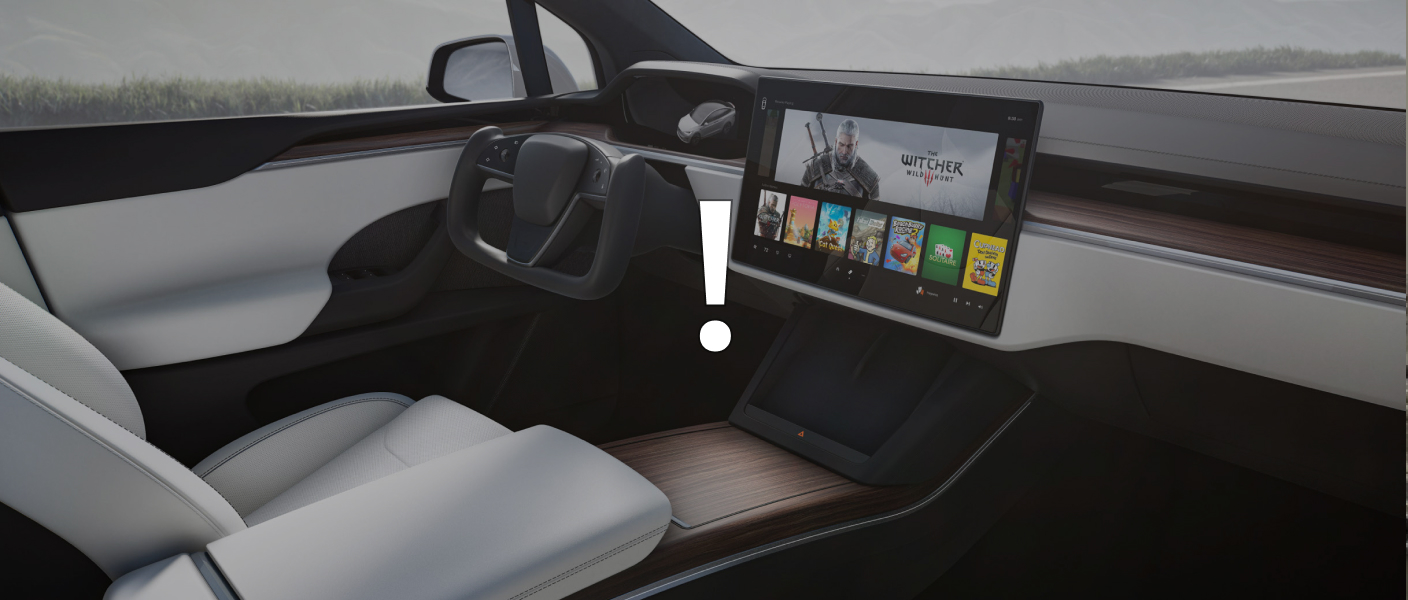This morning, Tesla released its 2020 Q4 quarterly report. As the quarter when Tesla made the strongest performance last year, people have had high expectations for the financial data even before the report was released. The actual data did not disappoint, with many indicators in multiple categories reaching new highs. However, for Tesla, “reaching new heights” seems to be nothing new.
But the refreshed Model S/X is still quite new, especially since it appeared in the PDF of the financial report.
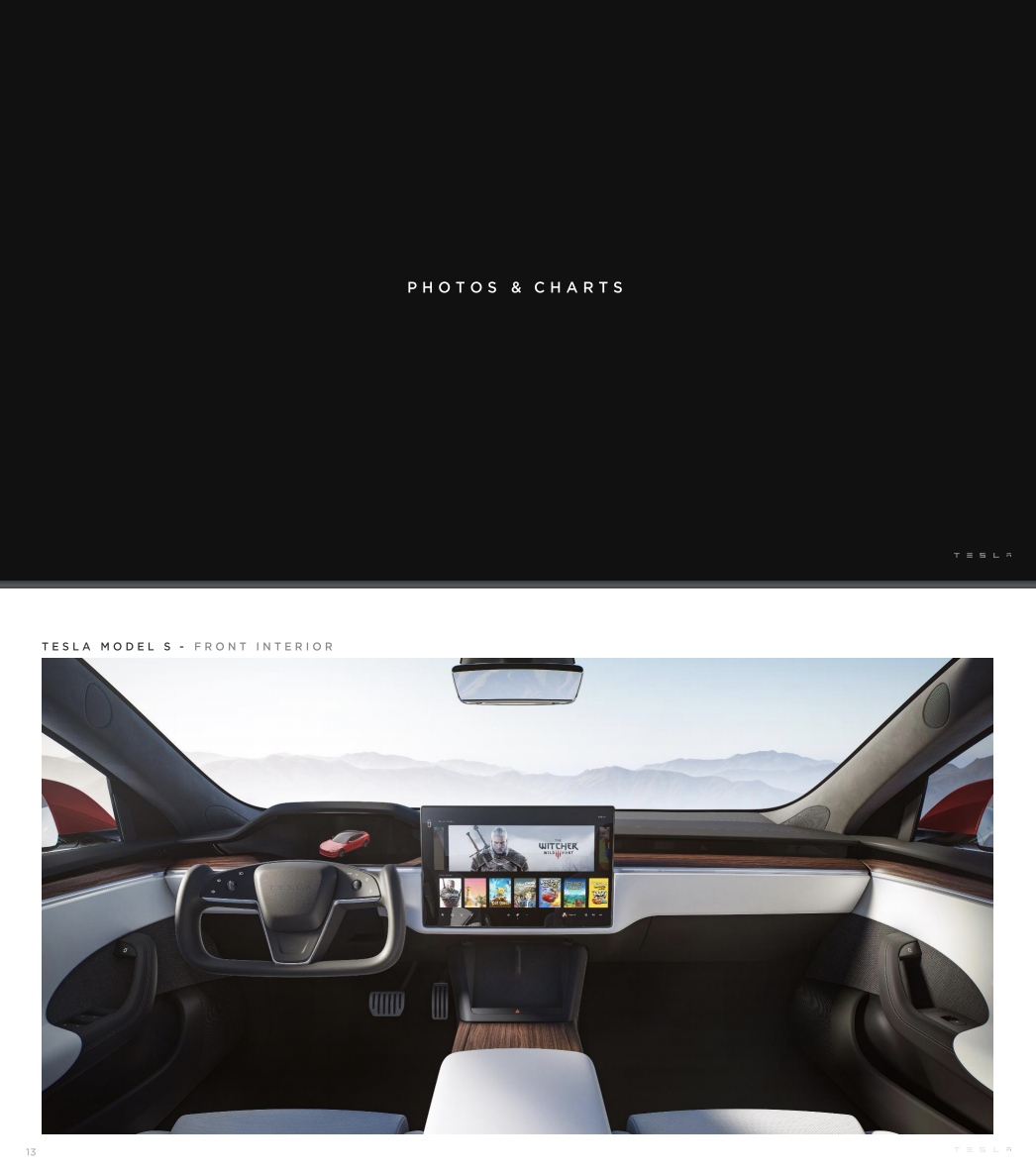
So whether you are reading the financial report or looking at cars, this article has both.
Financial Report Analysis
Financial Data
Tesla’s 2020 Q4 financial report set multiple historical records, with the main financial information as follows:
- Total revenue of USD 10.744 billion, a 22% increase from the previous quarter and a 46% increase from the same period last year;
- Automotive revenue of USD 9.314 billion (including USD 401 million from the sale of carbon emission credits), a 22.3% increase from the previous quarter and a 46% increase from the same period last year;
- Automotive profit of USD 2.244 billion, a 6.6% increase from the previous quarter and a 56% increase from the same period last year, with a vehicle gross margin of 24.1%;
- Gross profit of USD 2.066 billion, with a gross profit margin of 19.2%;
- Cash and cash equivalents increased by USD 4.853 billion, reaching USD 19.384 billion;
- Operating cash flow minus capital expenditures (free cash flow) was USD 1.868 billion;
- GAAP operating margin reached 5.4%.
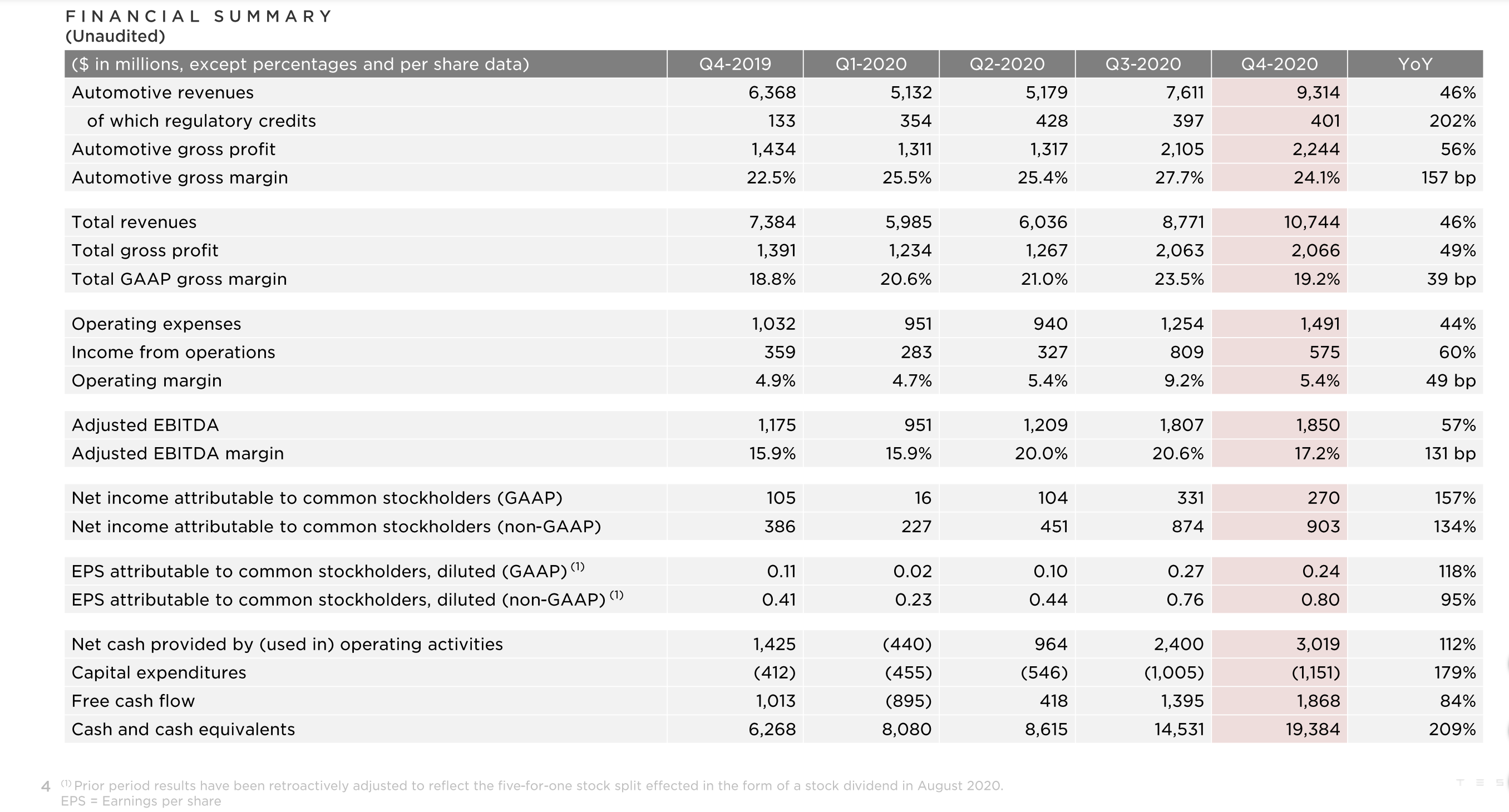
Tesla achieved profitability in all four quarters of 2020, and this was also its sixth consecutive profitable quarter. Q4 set a new record for historical delivery volumes and also set a new record for quarterly revenue of USD 10.744 billion and profit of USD 2.244 billion.
However, both the overall gross margin and vehicle gross margin in Q4 decreased. The GAAP operating margin fell from 9.2% in Q3 to 5.4% in Q4. Additionally, the Model 3/Y, which sold well in Q4, only increased its proportion of total sales by 0.5% compared to Q3, meaning that the proportion of low-profit-margin vehicles remained stable. Therefore, Tesla’s price reduction to boost sales could be one of the factors behind the decline in Q4 profit margin.
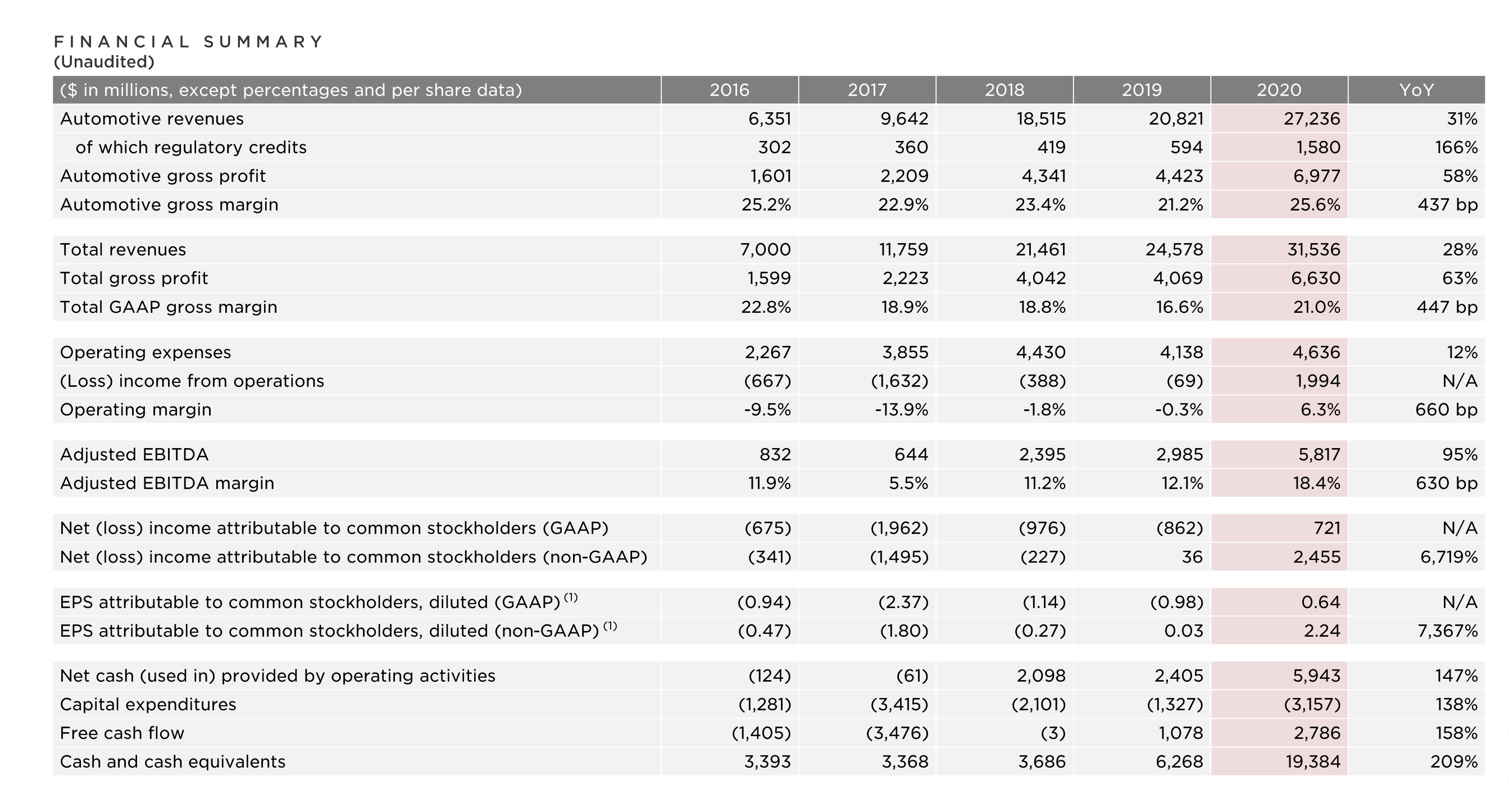 But throughout the year, Tesla’s revenue in 2020 reached $31.536 billion, with a total gross profit of $6.63 billion, a gross profit margin of 21%, and a net profit of $721 million under GAAP standards. This is the first year that Tesla has truly made money since its founding in 2003. By contrast, in 2019, Tesla’s revenue for the year was $24.578 billion, gross profit was $4.069 billion, gross profit margin was 16.6%, and net loss was $862 million under GAAP standards. This is why Tesla’s financial report describes 2020 as a turning point year for Tesla.
But throughout the year, Tesla’s revenue in 2020 reached $31.536 billion, with a total gross profit of $6.63 billion, a gross profit margin of 21%, and a net profit of $721 million under GAAP standards. This is the first year that Tesla has truly made money since its founding in 2003. By contrast, in 2019, Tesla’s revenue for the year was $24.578 billion, gross profit was $4.069 billion, gross profit margin was 16.6%, and net loss was $862 million under GAAP standards. This is why Tesla’s financial report describes 2020 as a turning point year for Tesla.
Tesla set a goal to deliver 500,000 vehicles in 2020, but the closure of the Fremont factory during the pandemic poured cold water on Tesla’s plans. After the first two quarters, Tesla only delivered 179,387 vehicles and often had no cars to sell in regions such as Europe where there was no local factory. During the first half of the year, only 31,164 Model 3s were registered in Europe, according to EV Sales statistics. Starting in Q3, Tesla began to accelerate production and delivery, and Musk sent emails to emphasize the goal of 500,000 vehicles. The production and delivery data for Q4 are as follows: Total production in Q4 2020 was 179,757 vehicles, including 16,097 Model S/X and 163,660 Model 3/Y. Total deliveries in Q4 2020 were 180,667 vehicles, including 18,966 Model S/X and 161,701 Model 3/Y.Tesla’s inventory cycle in the entire Q4 was 11 days, down 21% on a quarter-on-quarter basis from 14 days in Q3 and up 10% year-on-year from 10 days in the same period last year.
To increase production, the Shanghai factory implemented a three-shift system during Q4, and production capacity increased from the planned 150,000 vehicles per year to 250,000 vehicles per year. Model 3 production capacity in China, which could not be fully consumed domestically, was also exported to Europe in Q4. In the end, Tesla’s delivery volume in 2020 was set at 499,550 vehicles. Although Tesla did not achieve its goal of delivering 500,000 vehicles, Tesla’s execution and momentum in 2020, especially in Q4, were already in place.In 2021, although Tesla has not yet given a clear delivery target, Tesla CFO Zachary Kirkhorn stated at the shareholders meeting that Tesla still expects to achieve a 50% annual compound growth rate, and it is very likely to exceed this target in 2021. In other words, the minimum expected sales for this year are 750,000 vehicles. From Tesla’s current factory plan and production capacity, the goal of 750,000 vehicles is not a very ambitious one.
Sales foundation for 2021: factories
The Fremont factory in the United States currently plans to produce 500,000 Model 3/Y vehicles per year, while the production capacity of Model S/X has been increased to 100,000 vehicles per year. The former’s capacity will reach 100% status in Q1 2021, and the latter will also reach 100% capacity in Q1 after undergoing upgrades for the new Model S/X.
The production capacity of the Shanghai factory has now reached 250,000 vehicles per year, and the plan is to increase it to 450,000 vehicles per year. Model Y was put into production at the end of 2020 and has already started delivery, and the production capacity is also moving towards 100%.
The production capacity of these two factories that have been built will be the decisive factor for Tesla’s sales this year. Facing a huge demand for Model 3/Y in Fremont, the Shanghai factory will undertake more delivery tasks in Europe and the Asia-Pacific region this year. However, of the annual production capacity of 450,000 vehicles in Shanghai, only 200,000 are for Model Y, so it is still difficult to meet the huge demand.
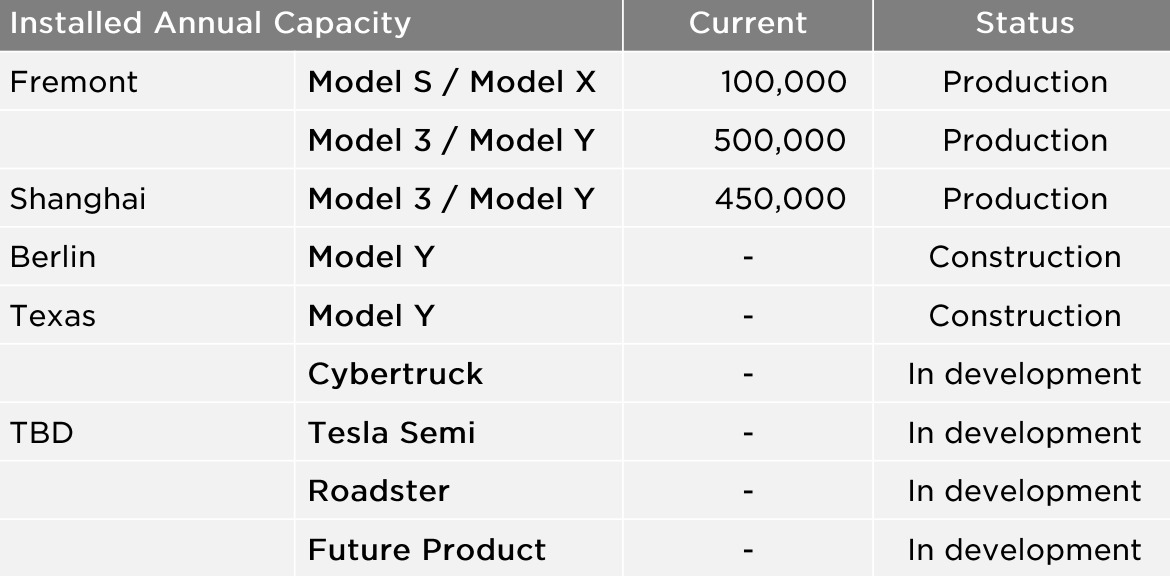
The under-construction Berlin factory was delayed last year due to environmental policies and lack of construction permits. Musk visited Germany multiple times to promote the factory construction. The Berlin factory, which is expected to be completed in July 2021, will only produce Model Y. The Texas factory, also under construction, will also produce only Model Y.
Charging stations and energy storage
In Q4 2020, Tesla’s global Supercharger station count reached 2,564, with an increase of 383 compared to the previous quarter, a 17% increase month-on-month, and a 41% increase year-on-year. The number of Supercharger stalls reached 23,277, with an increase of 3,840 compared to the previous quarter, a 19.7% increase month-on-month, and a 45% increase year-on-year.Q4 PV deployment increased by 86 MW, a MoM increase of 50.8% and a YoY increase of 59%, while energy storage deployment increased by 1,584 MW, a MoM increase of 108% and a YoY increase of 199%.
Currently, Tesla’s PV and energy storage businesses in China do not have particularly large actions, but the two key parts that are being produced in the Shanghai factory’s phase three construction include superchargers.
The ultra-fast-charging factory invested by the phase three plant in Shanghai with a cost of 42 million yuan has a planned annual output of 10,000 units, most of which will be 250 kW V3 charging equipment, which will be put into operation in Q1 2021. As of 2020, Tesla deployed about 670 superchargers and about 5,300 supercharging piles in China. The annual output of 10,000 units of the phase three factory will be used not only in China but also in the construction of the supercharging network in the Asia-Pacific region.
Upcoming Major Upgrade to Autopilot
At the time of Tesla’s Q3 earnings release, it started pushing FSD Beta software with “city automatic driving” capability on a small scale. The new version of FSD uses the 8 cameras of the vehicle to collect surround-video materials, and the neural network for environment detection and recognition contains about 1,000 independent output prediction units.
The system can also use corner case materials transmitted by the vehicle during driving to improve the “experience” of FSD through AI training based on deep learning. After several months since the first small-scale release, Tesla has already pushed 11 software updates for FSD Beta through the above-mentioned iterative process.
During this process, not only the capabilities of FSD Beta have been continuously improved, but Tesla’s collection of real driving environment data has also increased with the mileage. Tesla’s Dojo supercomputer, which is used to process these real road video materials, is still in development. Musk previously stated that its performance will exceed that of the world’s most powerful supercomputer, Fugaku, by more than two times. He also revealed that Dojo will be unveiled roughly in 2021.
After summarizing the above, today’s surprise of Model S/X upgrades was unexpected in the financial report.
Major Upgrades to Model S/X
Model S/X has been updated today, and the magnitude of the changes is even more surprising than the financial reports.
What it should look like in 2021
First of all, the redesigned Model S/X looks like this.
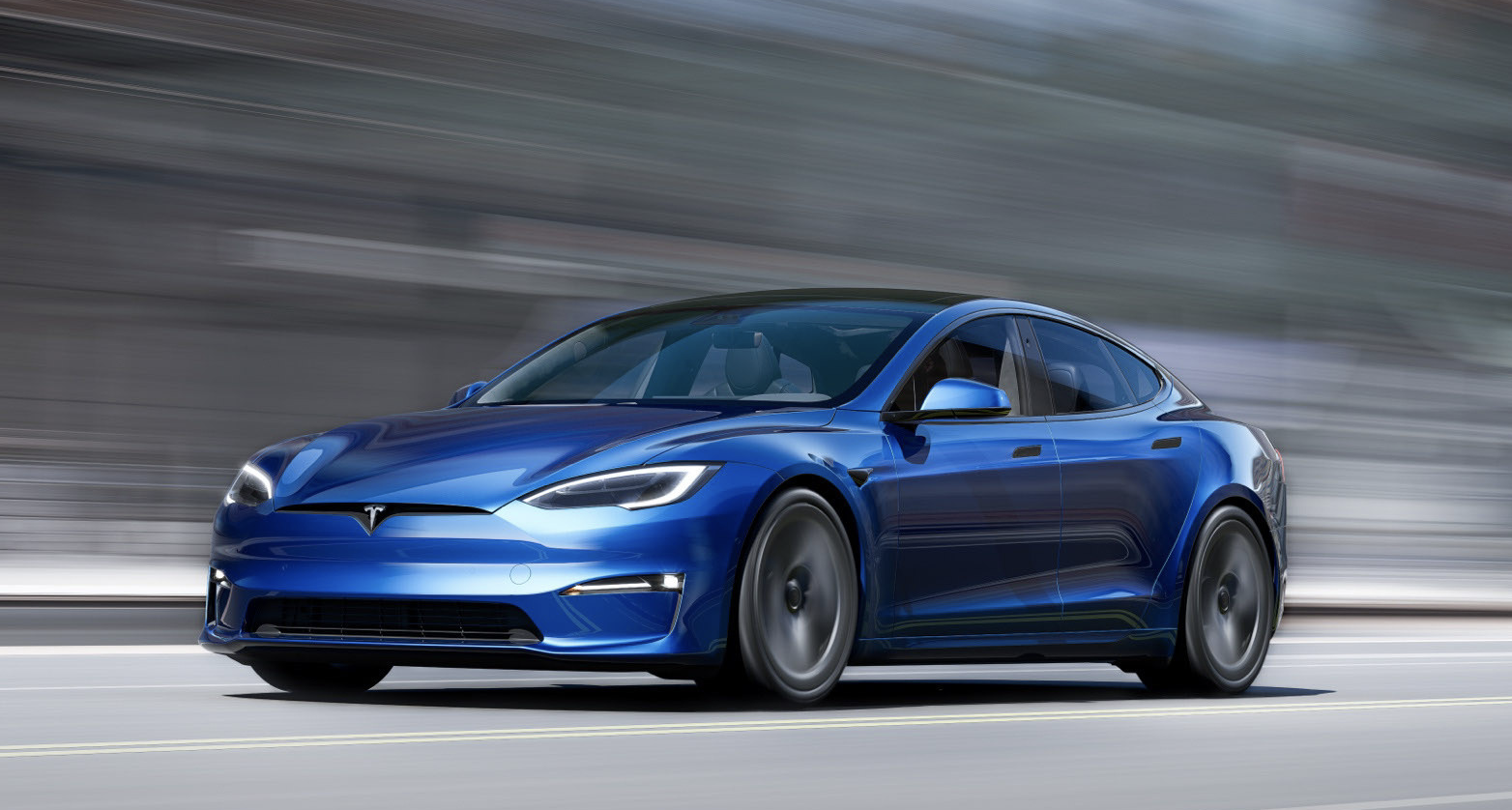 The interior of the refreshed Model S/X looks like this.
The interior of the refreshed Model S/X looks like this.
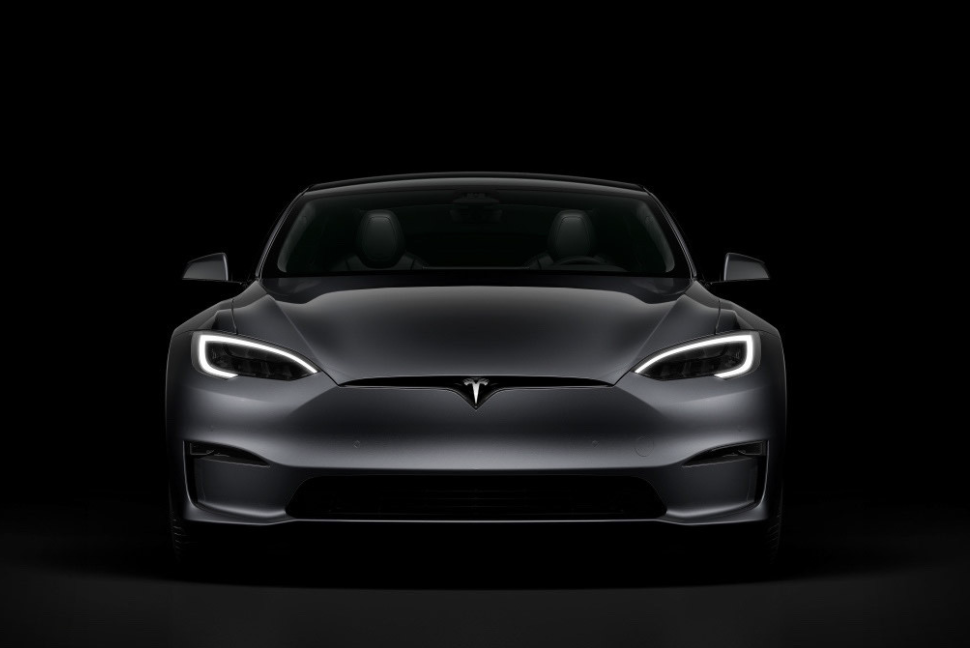
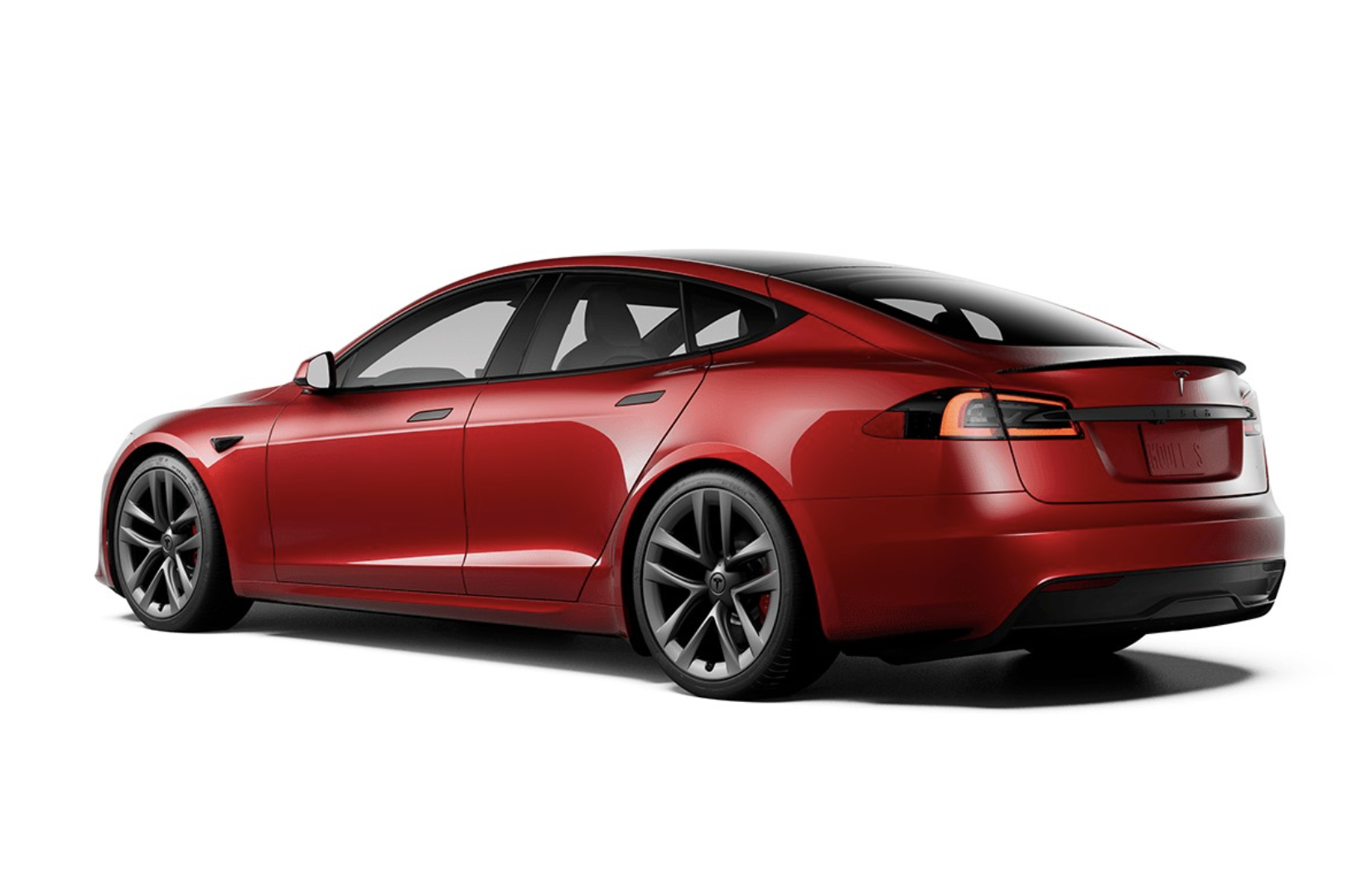
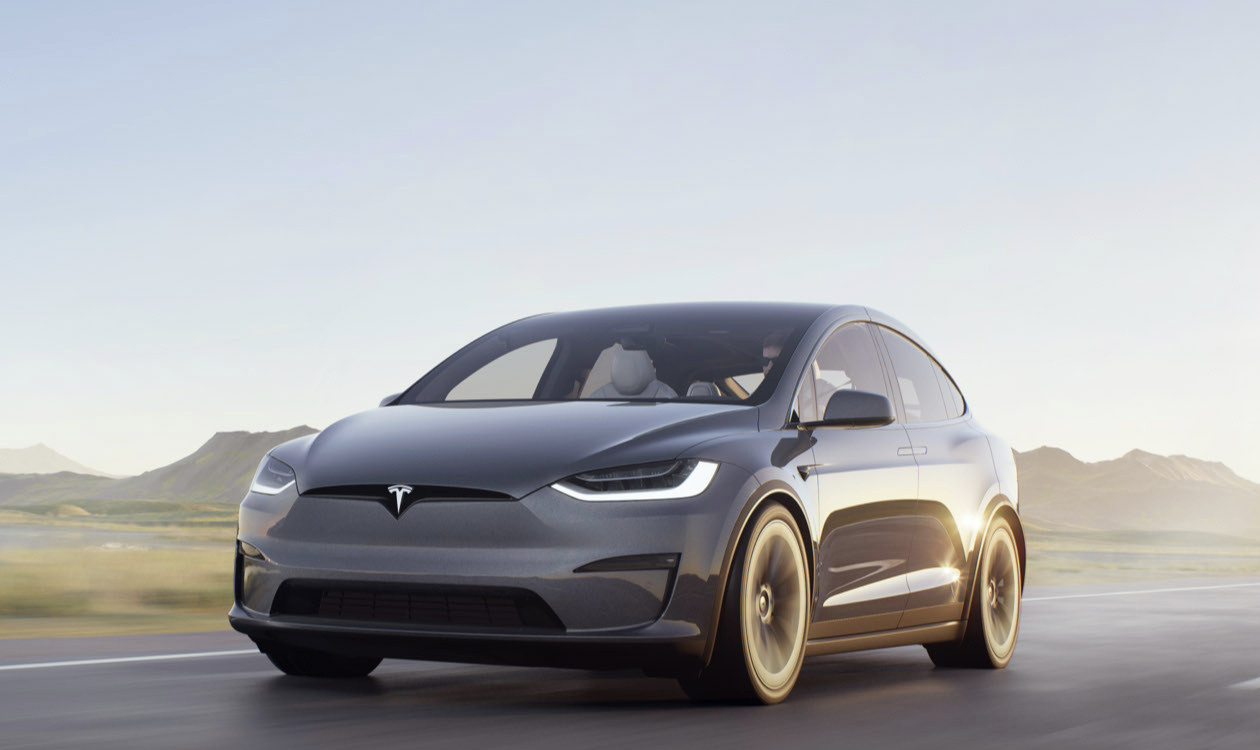
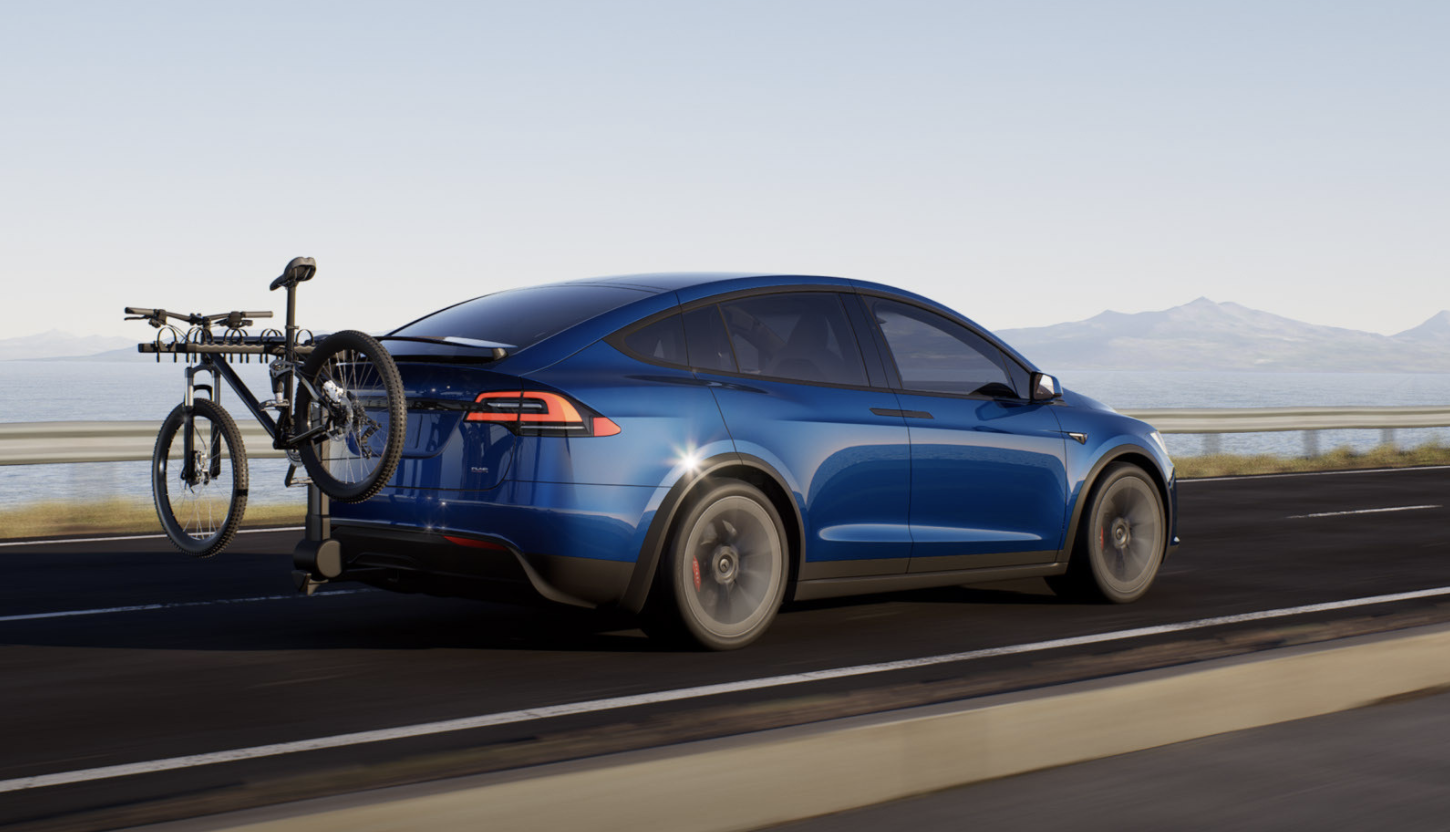
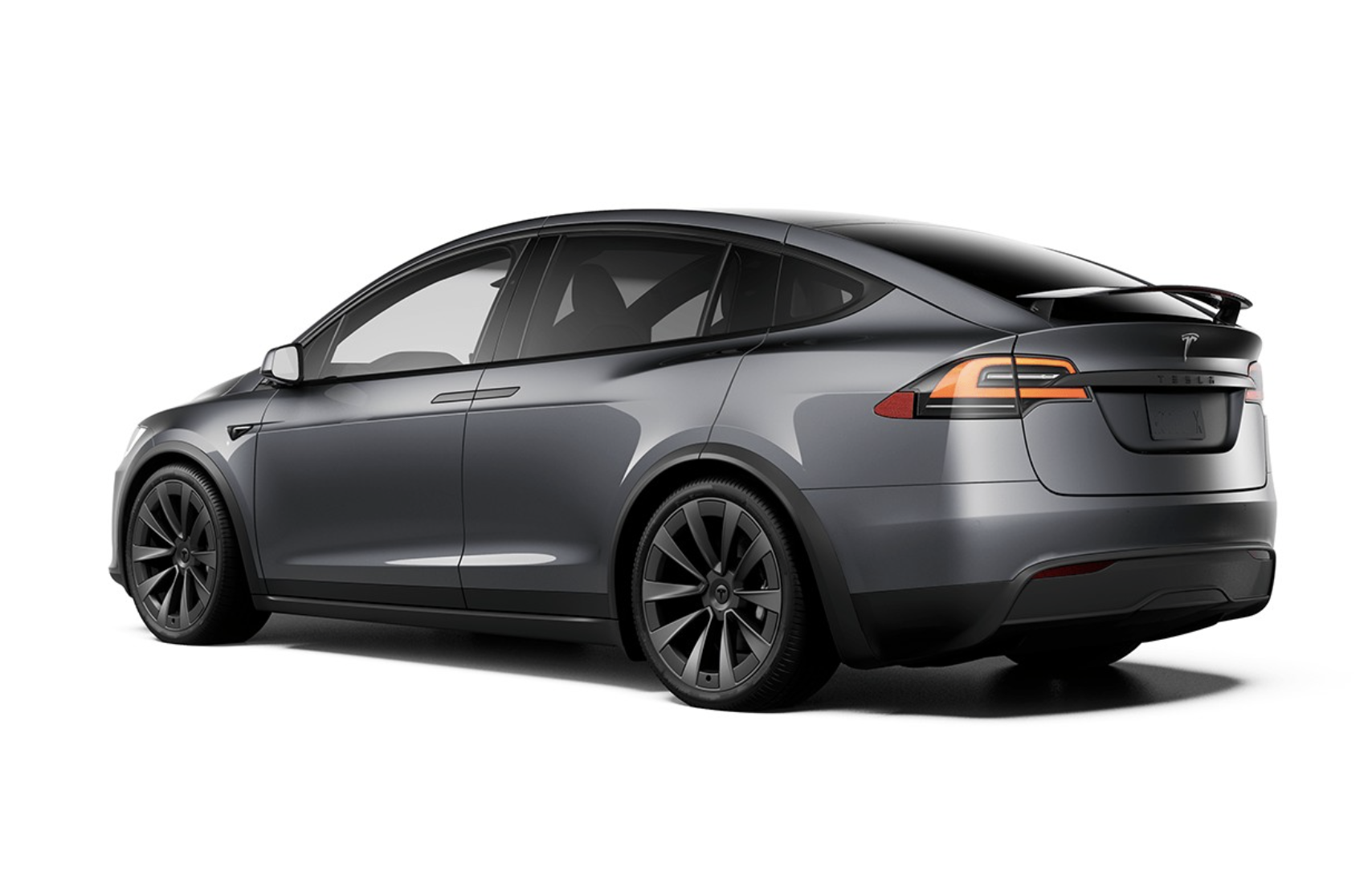
First off, let’s talk about the exterior. The Model S/X has made some obvious design changes that are more “2021,” including a new bumper, new wheels, and a new rear diffuser.
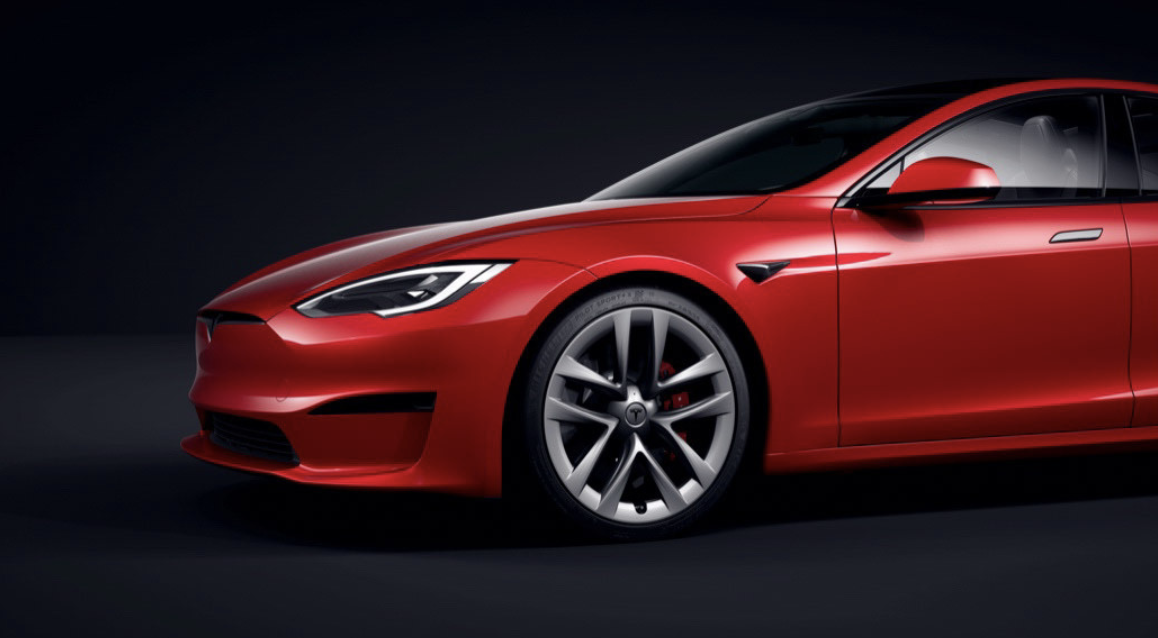
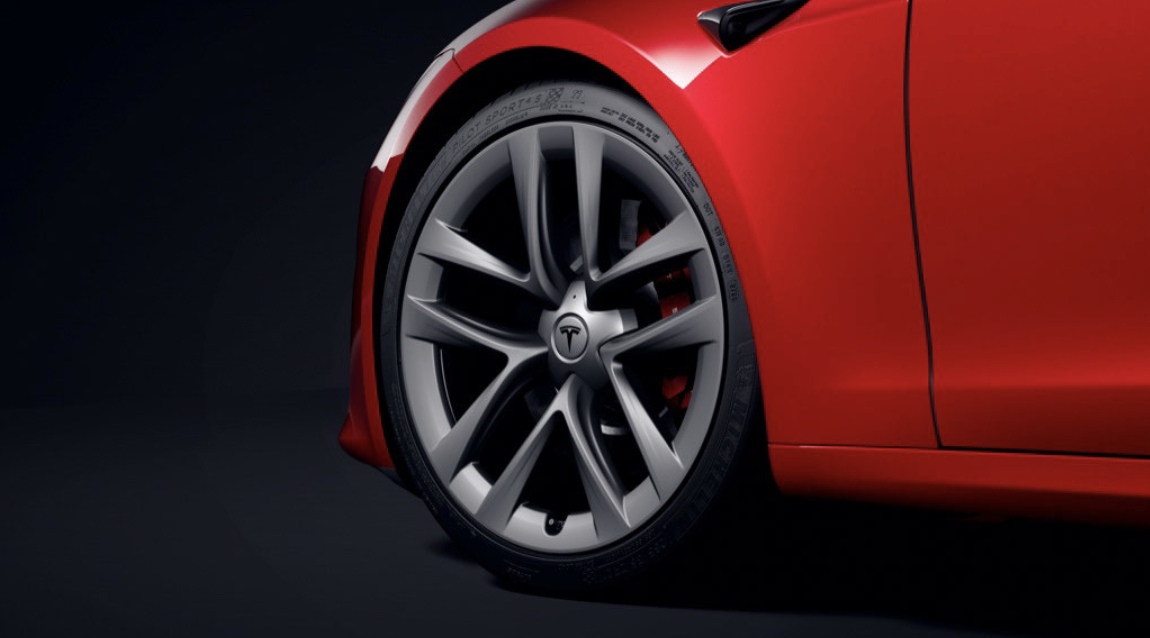
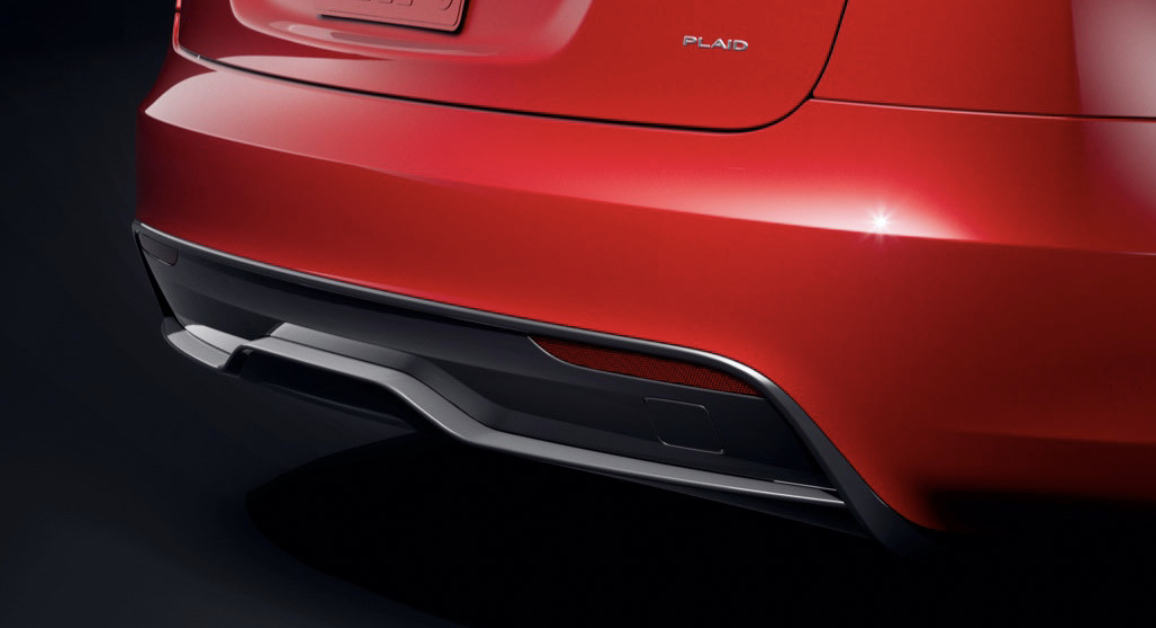
Although the Model S/X is positioned higher, the updated design is more similar to the style of the Model 3/Y. And whether it’s the new bumper air intake, wheel rim aerodynamic design, or optimized rear spoiler, they all have one thing in common – more efficient aerodynamics.
The optimized Model X has reduced its drag coefficient to 0.25, making it the SUV with the lowest drag coefficient in the world, according to Tesla. The Model S’s drag coefficient has dropped to an amazing 0.208, and Tesla officially states that the Model S is “the most aerodynamic production car on Earth.”### Double improvement of endurance performance
The Model X with enhanced aerodynamics has achieved improvements in acceleration while obtaining EPA mileage ratings of 574 km and 544 km for the long-endurance and Plaid versions, respectively.
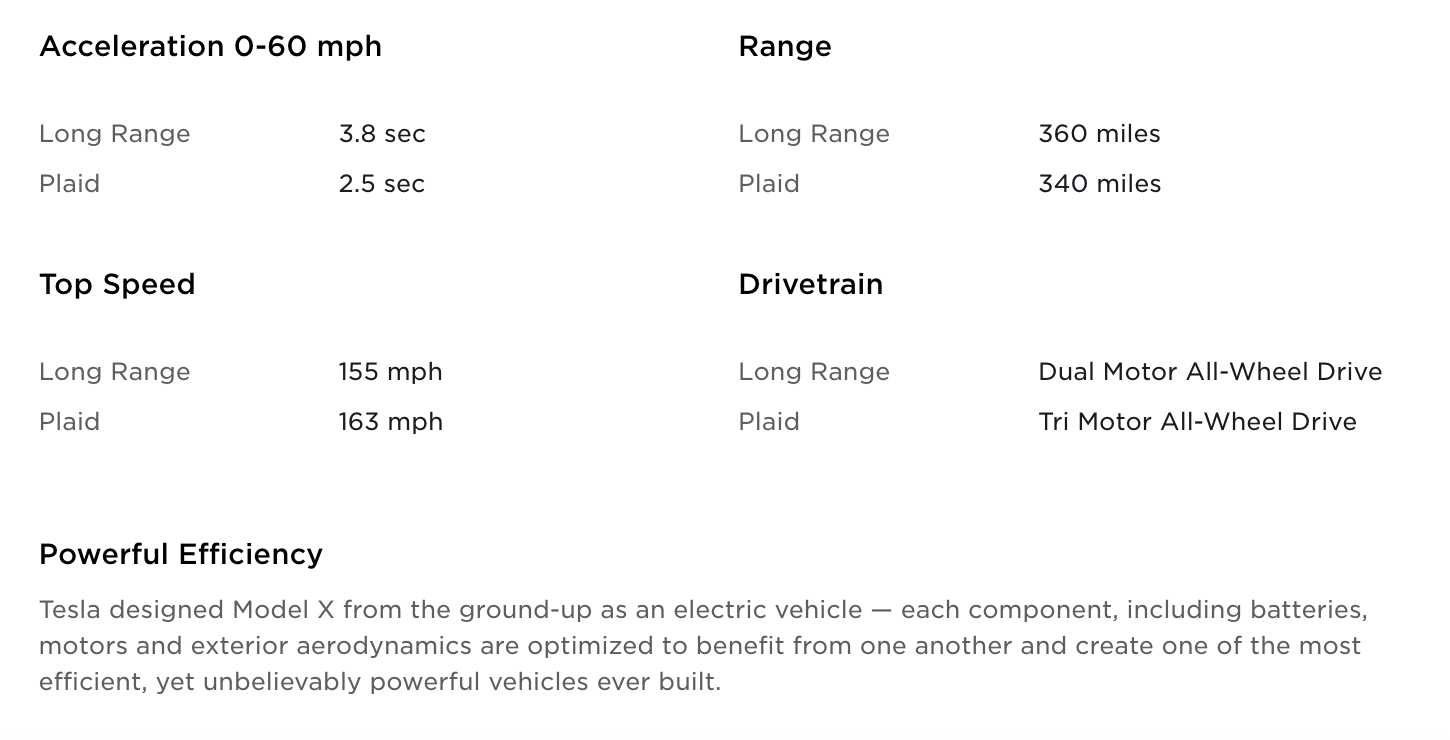
The long-endurance version of the Model X on the Chinese official website has an acceleration rate of 3.9 seconds from 0 to 100 km/h, an estimated mileage of 580 km, and a price of 7.9999 million yuan.
The Plaid version of the Model X has an acceleration rate of 2.6 seconds and an estimated mileage of 547 km, priced at 9.9999 million yuan.
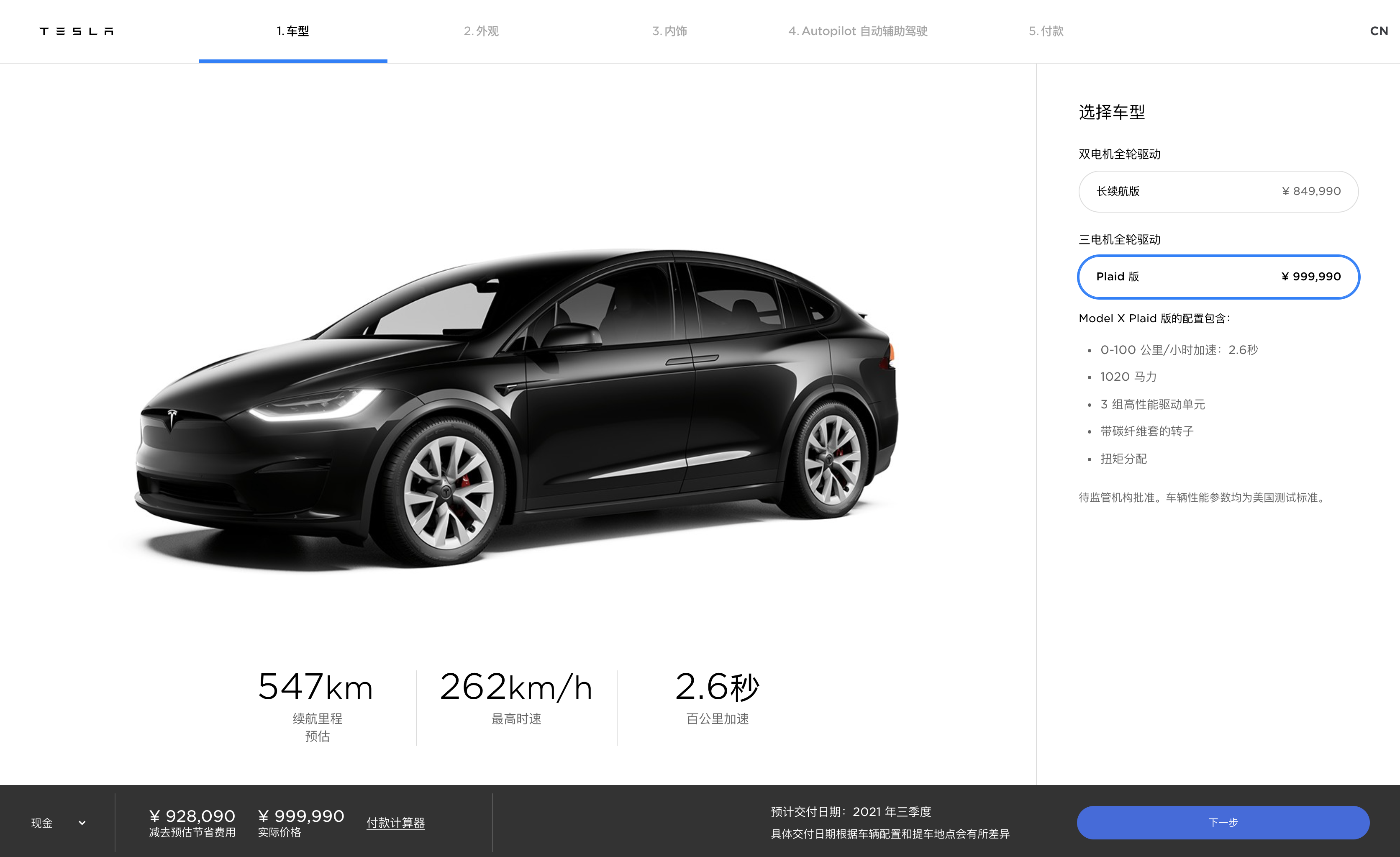
The long-endurance and Plaid versions of the revamped Model S have EPA mileage ratings of 659 km and 624 km, respectively. In addition to those, there’s an ultra-high-performance Plaid+ version, which boasts an EPA-mileage rating exceeding 832 km.
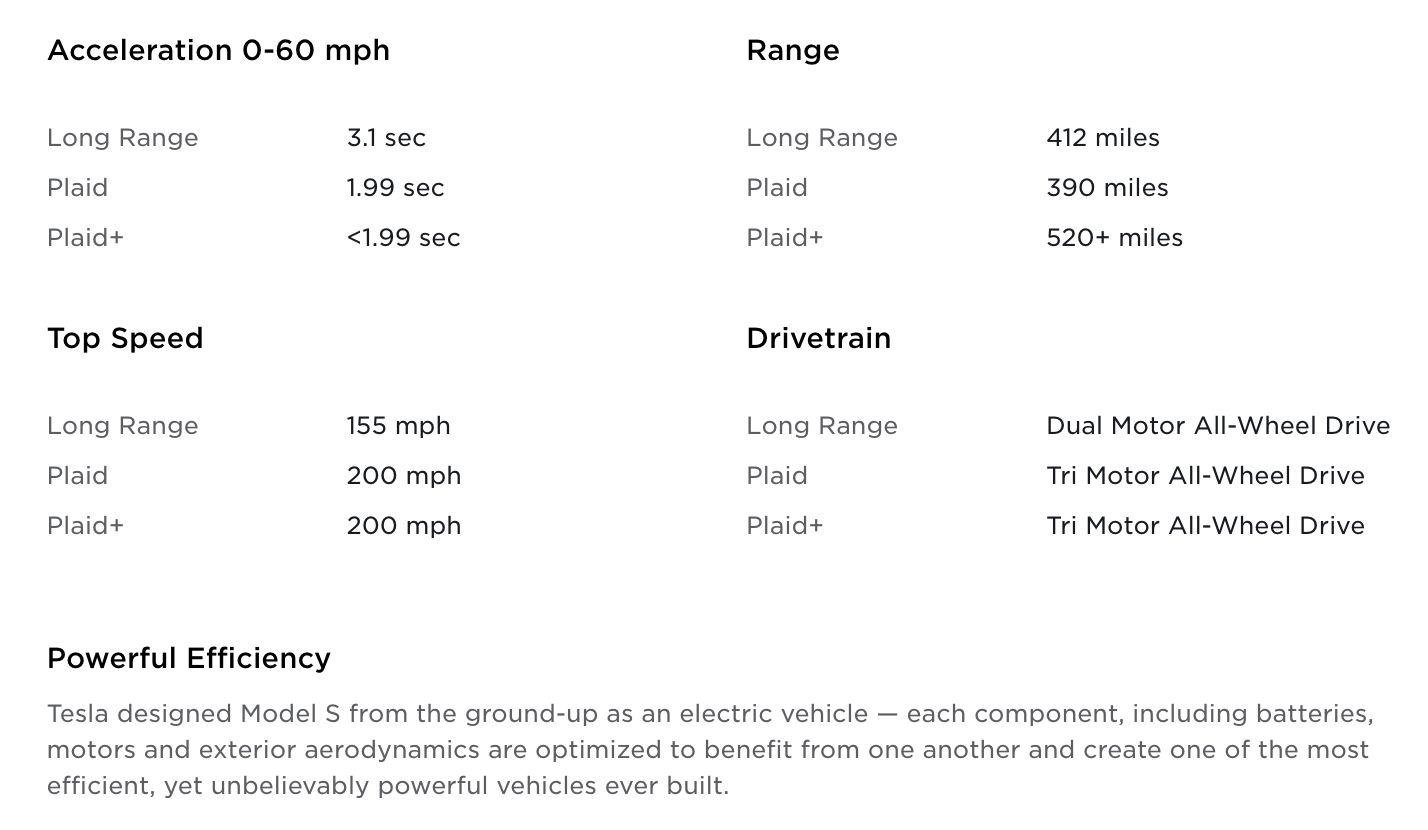
The long-endurance version of the Model S on the Chinese market has an acceleration rate of 3.2 seconds from 0 to 100 km/h, an estimated mileage of 663 km, and a price of 7.9999 million yuan.
The Plaid version has an acceleration rate of 2.1 seconds and an estimated mileage of 628 km, priced at 9.9999 million yuan.
The Plaid+ version has an acceleration rate of less than 2.1 seconds and an estimated mileage exceeding 840 km, priced at 11.749 million yuan.
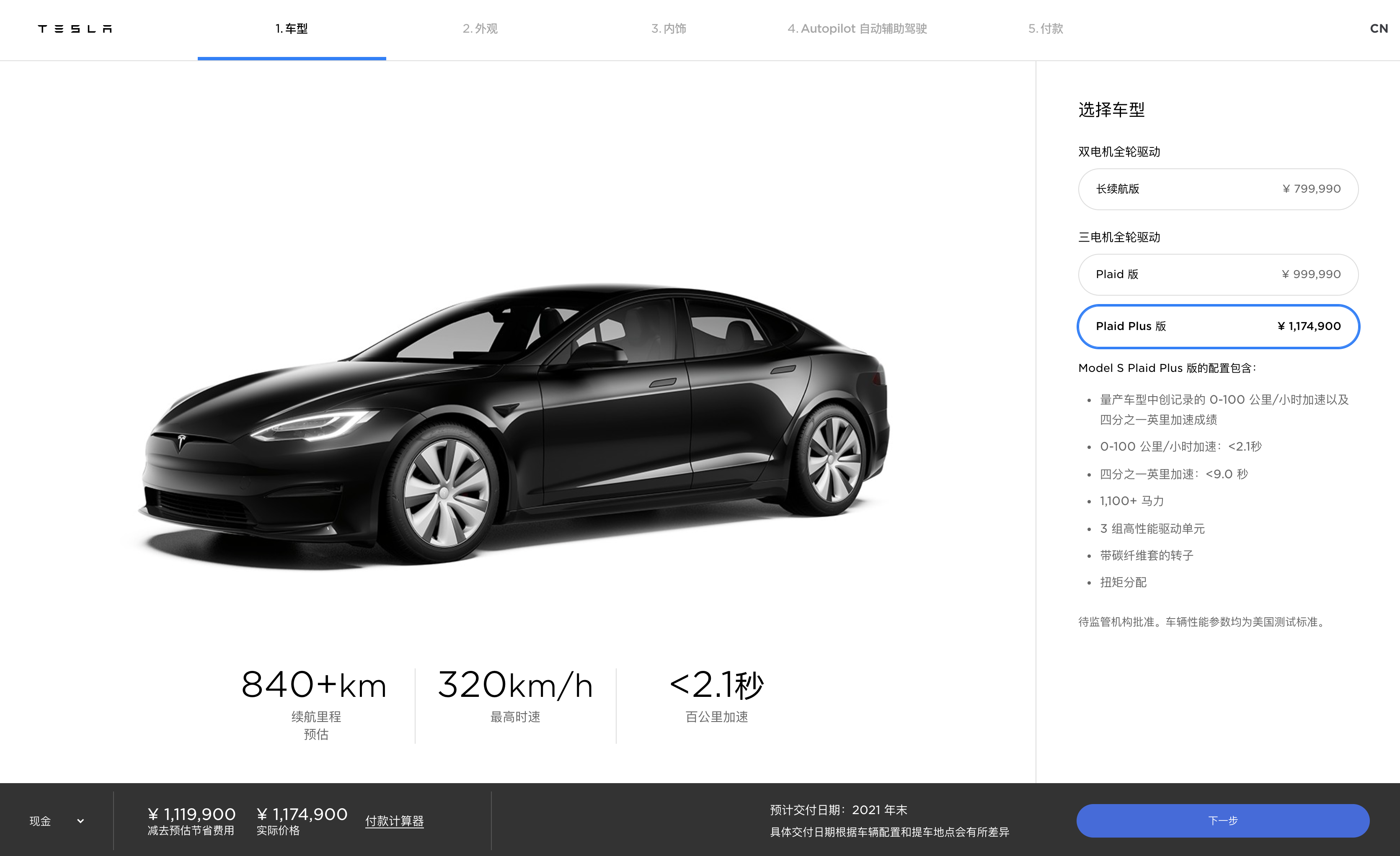
The base Model S/X series now delivers acceleration times of 3.2 seconds and 3.9 seconds from 0 to 100 km/h, respectively, after the revamp. Such figures are impossible for any other electric vehicle manufacturer with competing products, and even serve as the acceleration ceiling for many high-performance gasoline-powered cars of the same type.
However, as mentioned earlier, these are merely Tesla Model S/X’s base versions. The most powerfully accelerated three-motor Model S Plaid+ version boasts a record of being the world’s only mass-produced vehicle capable of accelerating from 0 to 60 mph in just 2 seconds.Yes, even the Bugatti Chiron with 1500+ horsepower cannot achieve this acceleration performance. And that Model S Plaid+ which has the fastest 0-60 mph acceleration in the world and EPA range of 520+ miles could also have the longest range among pure electric vehicles.
While other companies are wavering between performance and range, Tesla uses Model S Plaid+ to directly achieve two sets of world’s firsts in performance and range. Had this been on Bilibili, the barrage would be full of “amazing”.
Interior: Surprising Delight
The interior can be said to be the highlight of this Model S/X redesign. At the moment I saw the redesign pictures in the financial report, I felt a bit of a “once in a lifetime” feeling: Tesla has finally made a complete overhaul of the “antique interior” that has been in use since 2012.
Take a look at this steering wheel, the aircraft-like shape is very futuristic. Moreover, upon a closer look, you will notice that Tesla has removed the levers on the left and right of the steering column, and integrated the headlights, turn signals, wipers and other things into roller surrounds on both sides of the steering wheel through touch control.
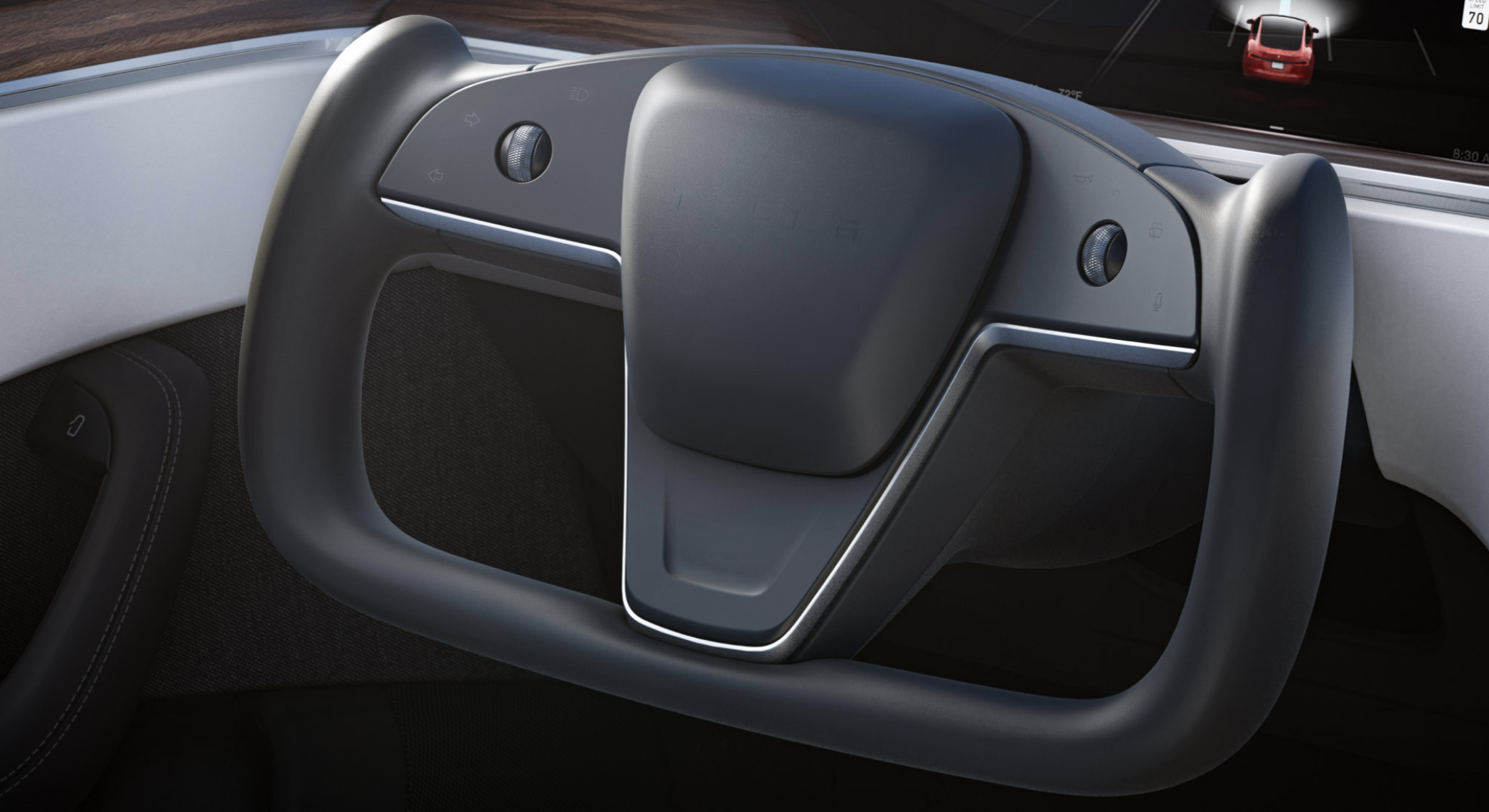
However, the way to open AP and how to shift after being changed like this have become questions in my mind.
Some colleagues suggested that Tesla may use voice control to open AP and shift. I think there may be a switch behind the handles on both sides of the steering wheel that can be blindly operated with the index finger.
A senior fan of Tesla’s garage thinks that gear shifting can be performed by double-pressing or pressing the brake pedal for a long time, while others think it can be done through touchscreen operation on the central control screen.
In addition, we also reported on a Tesla steering wheel patent last February, which mainly integrates more frequently used operations into the steering wheel, and shifting is also through steering wheel touch operation.
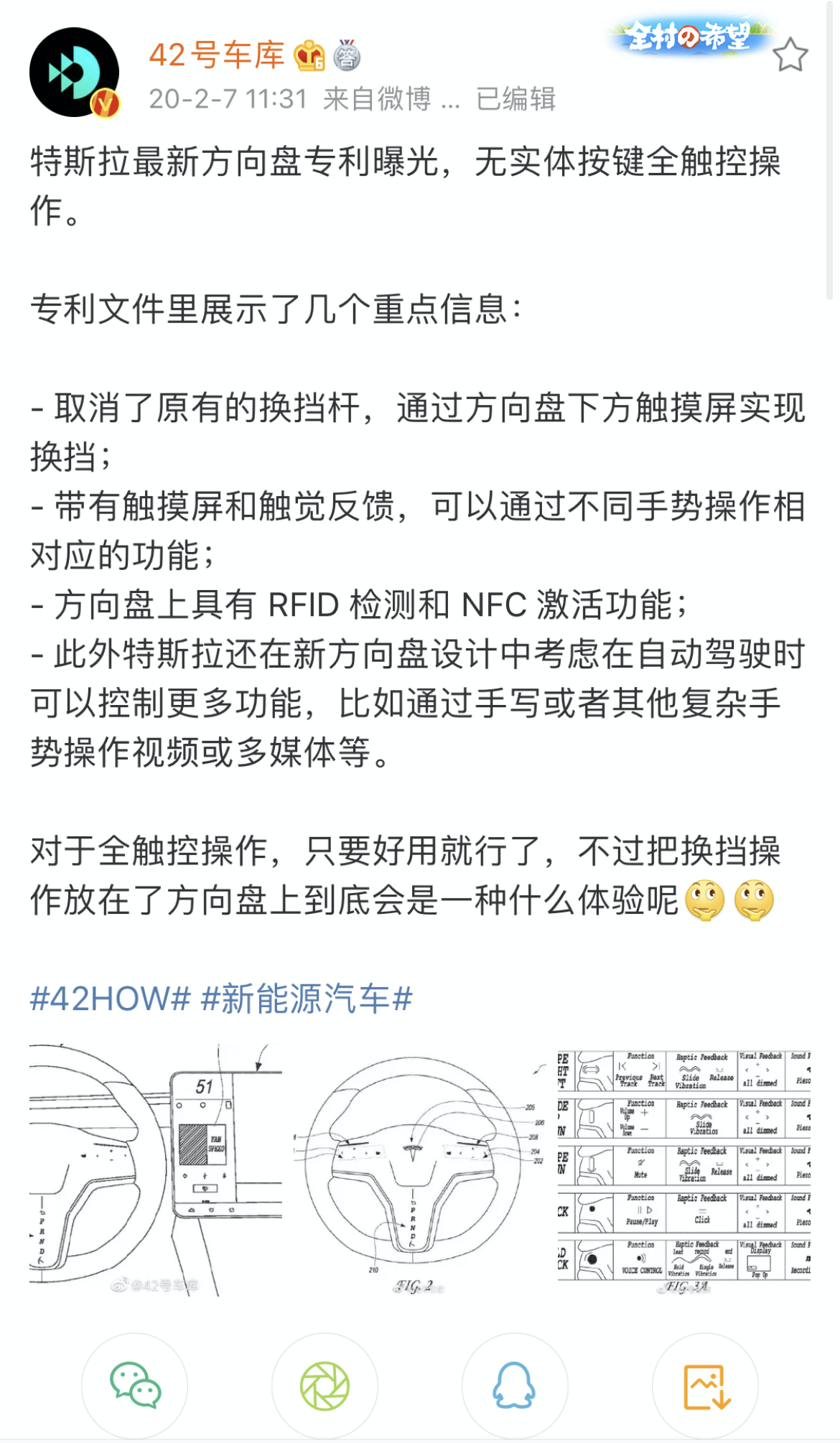
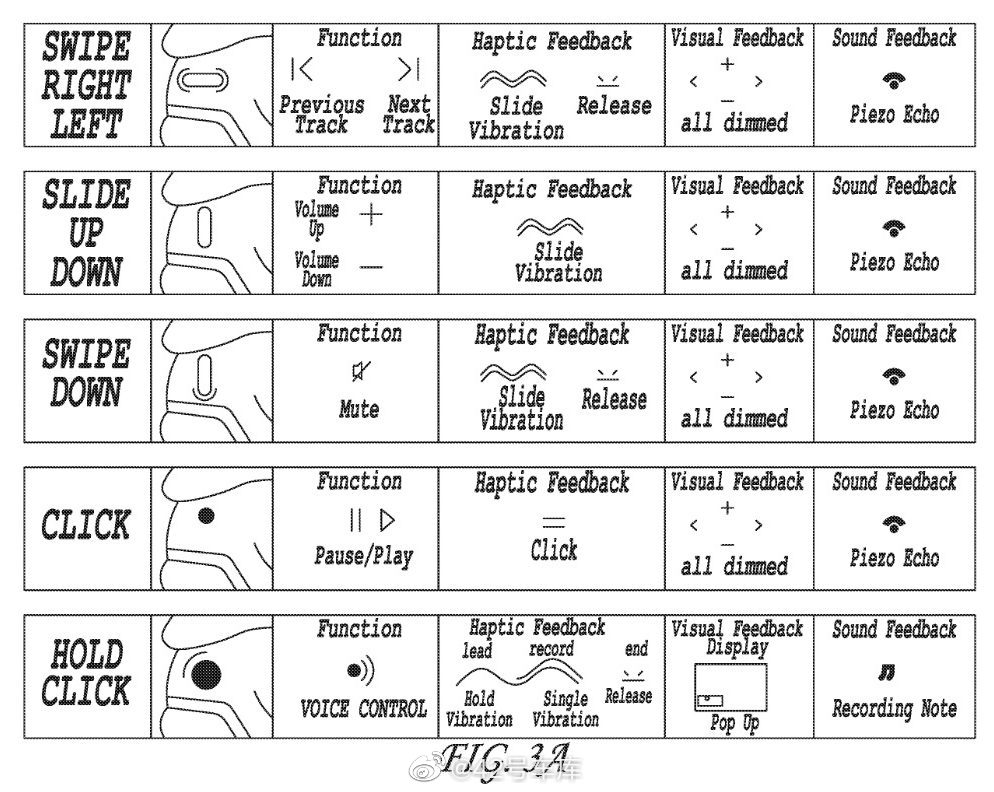
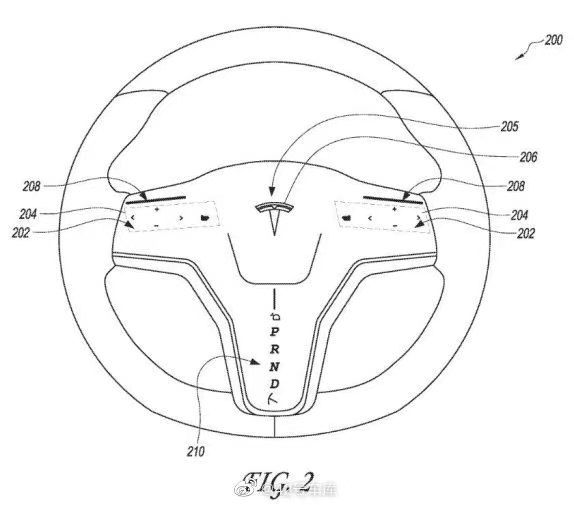
However, the production car style is more radical than the patent at the time, and the actual logic may have undergone some changes. But it can be confirmed that this Model S/X has once again integrated Tesla’s further new thinking on the concept of “focus on driving” in terms of driving logic.Here is the English Markdown text with HTML tags preserved:
The new 17-inch center touchscreen is now horizontal, just like the one in the Model 3, with a resolution of 2200 × 1300. According to the official statement, it also supports left-right adjustment.
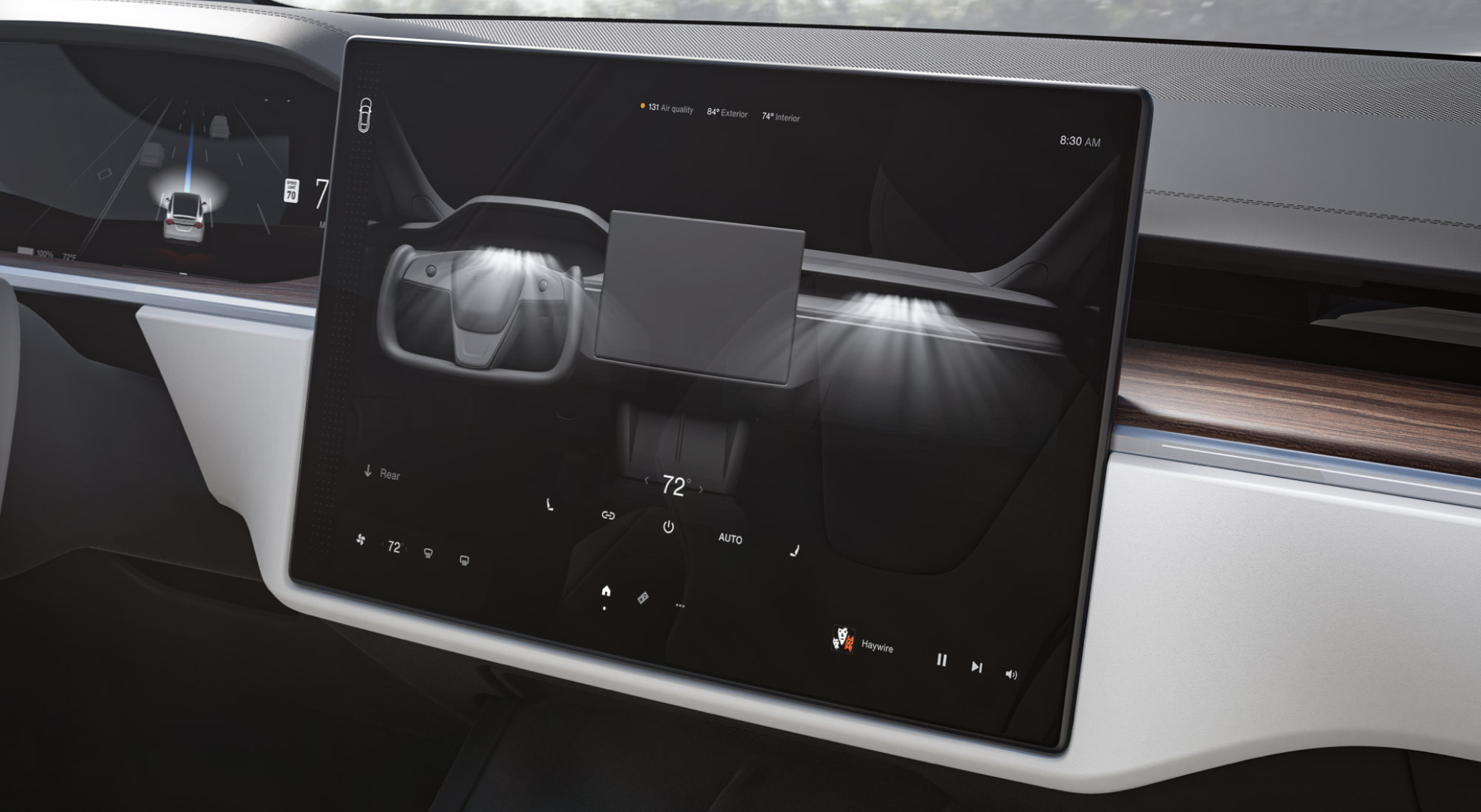
The left-right adjustment detail shows that Tesla has considered the other passengers besides the driver. Then I saw this picture.
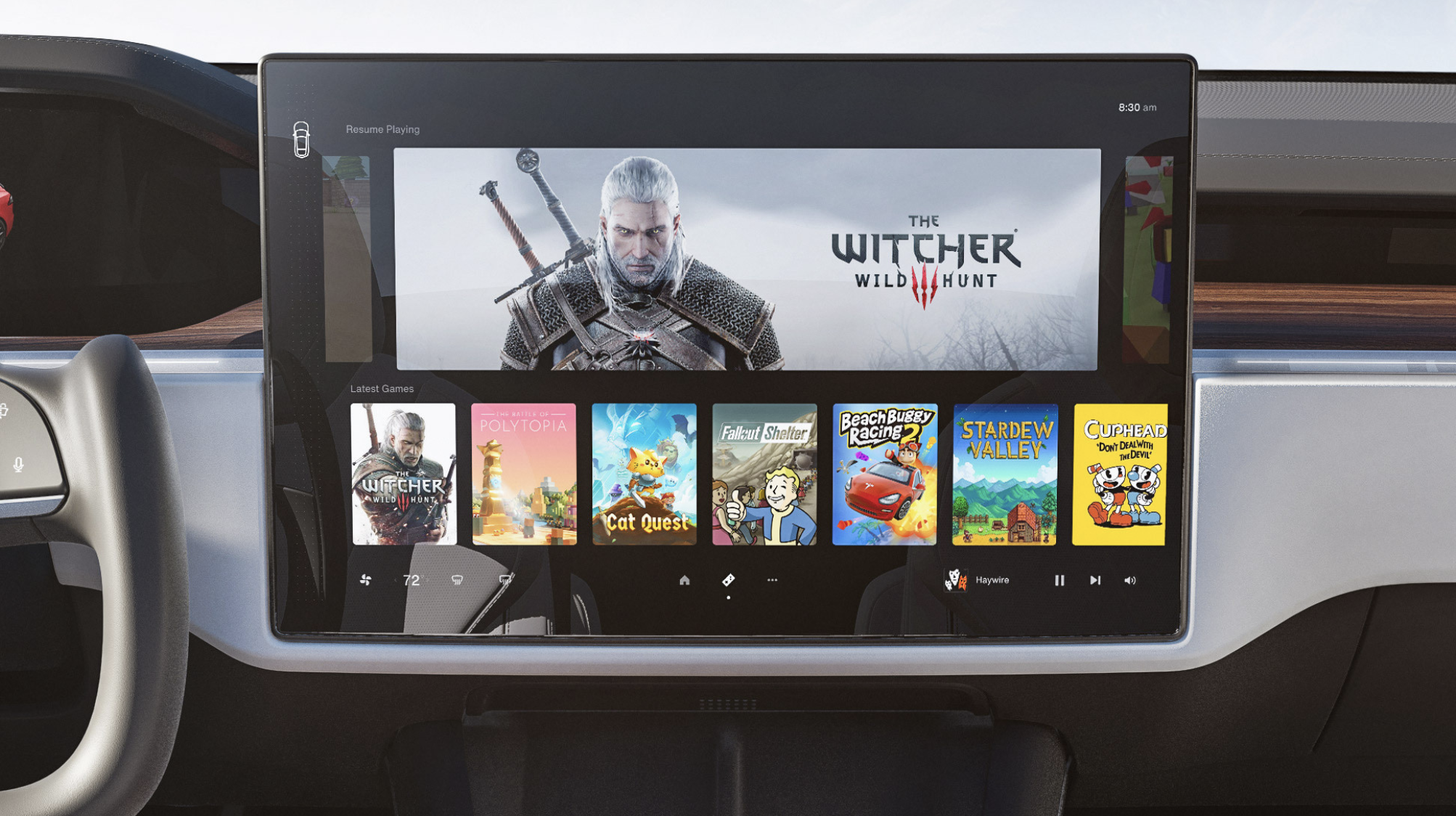
You might wonder why there are so many games on the screen, especially why a blockbuster game like Witcher 3 is even shown on the cover. It is because the new S/X is equipped with a processor that has a computing power of 10 TOPS. If you don’t have any concept of this number, it is roughly equivalent to that of a PS5. This makes the new Model S/X the most powerful gaming machine in a car.
To enable rear passengers to play games, Tesla has also prepared a screen for the rear seats. Both screens can be operated with a Bluetooth controller.
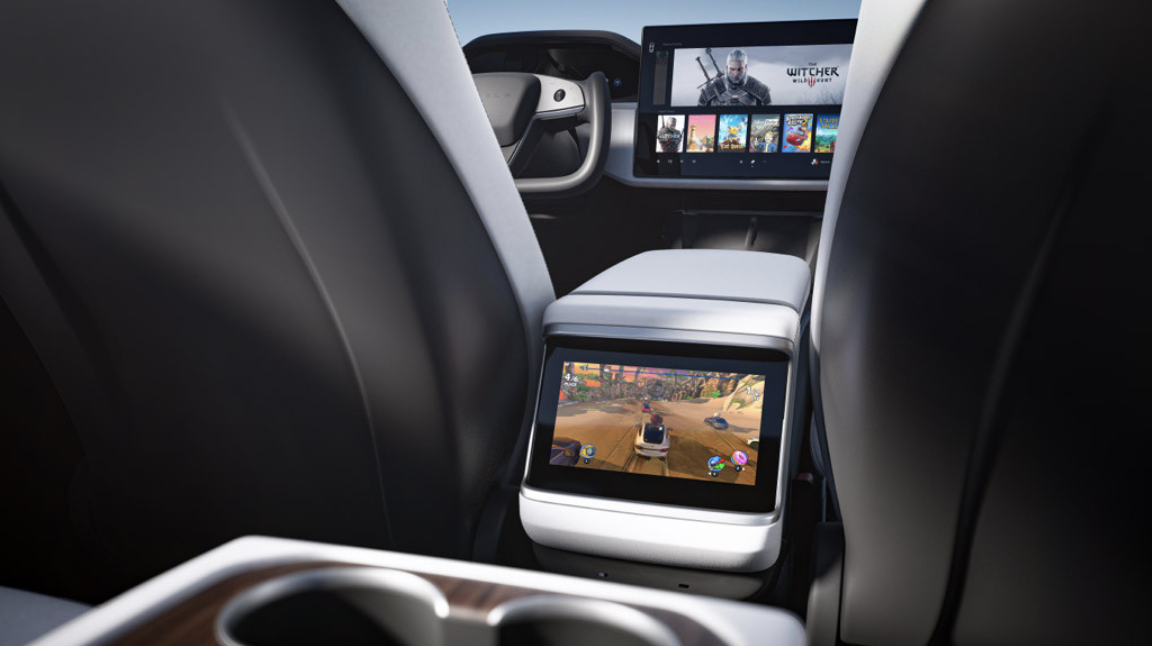
The lower section of the center console has been revised to include two wireless charging slots, just like the Model 3/Y.
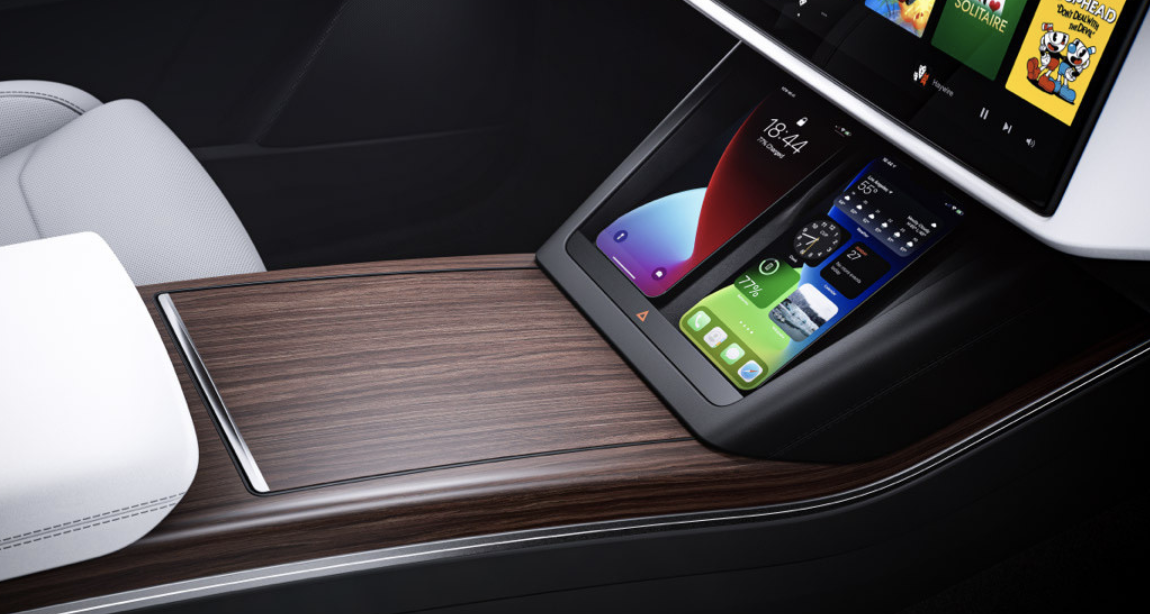
In addition, the new Model S/X interior features the same wood trim as the Chinese-made Model 3/Y, and other design elements such as hidden air vents and button door handles are inherited from the Model 3/Y. These all demonstrate that “Tesla has officially formed its own distinctive interior design logic and image since the Model 3”.
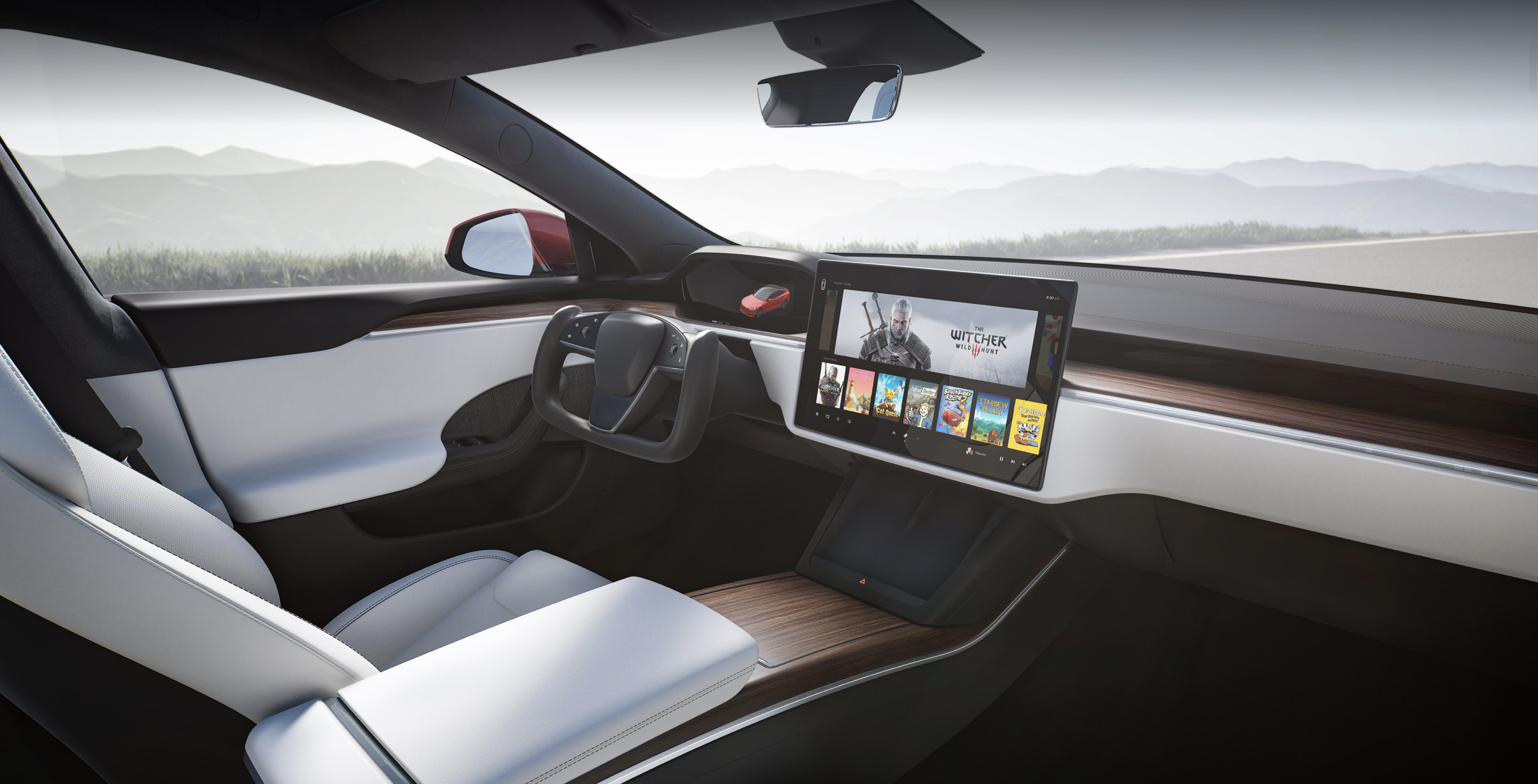
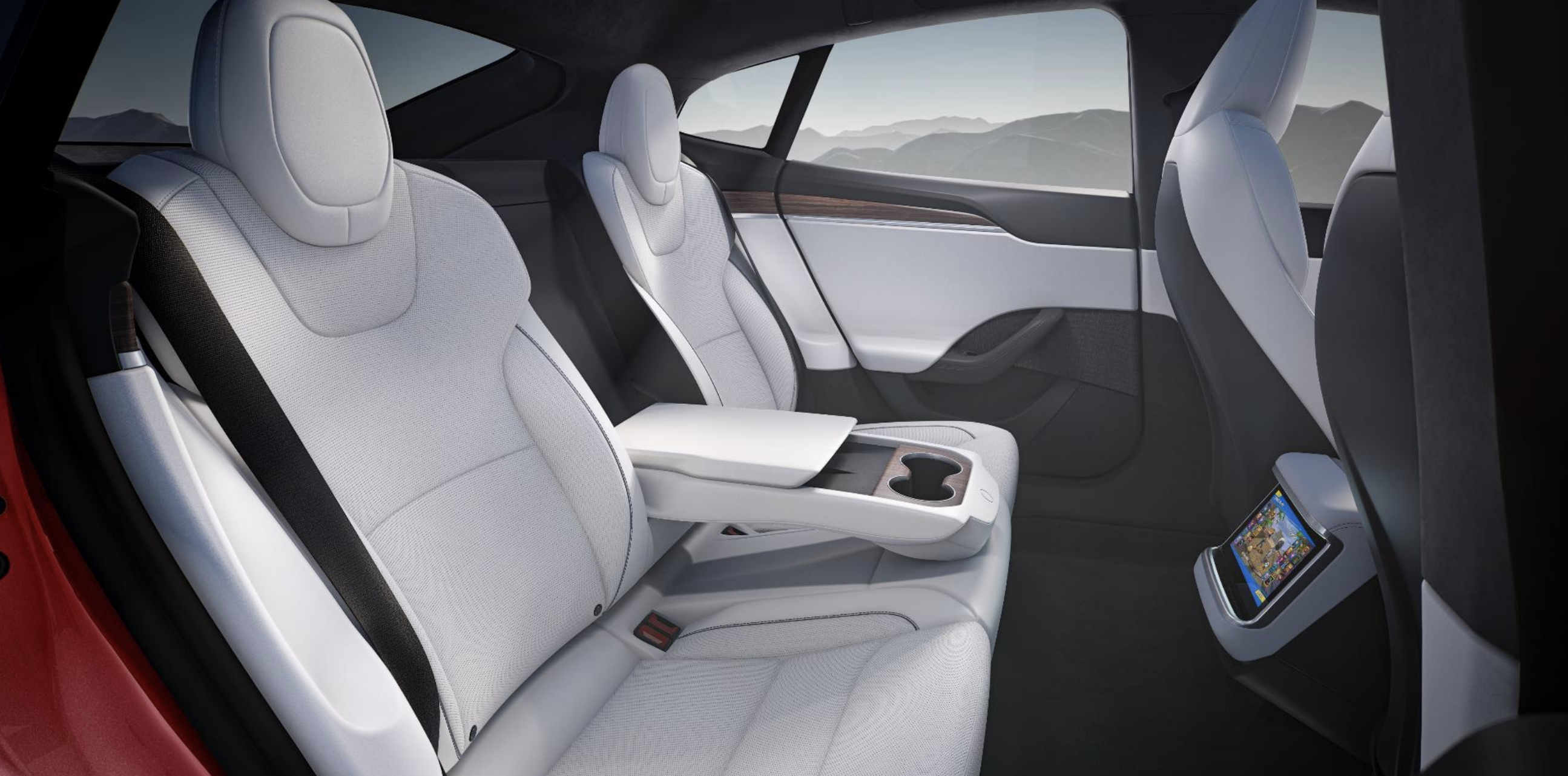
However, under this conclusion, I have a question. Why does the new Model S/X still have an instrument panel?
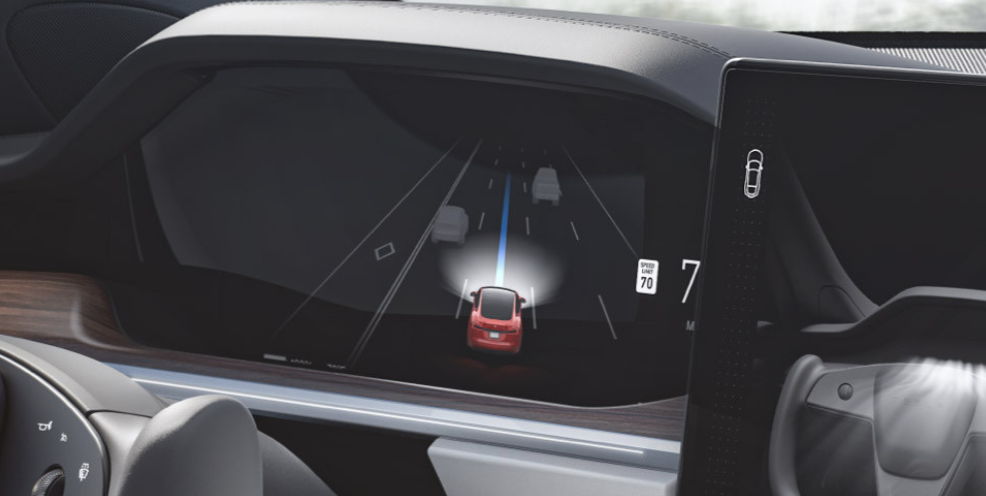 The design of the Model 3’s dashboard screen is one of the main reasons I like its interior concept. Without the dashboard screen, the overall design of the car is symmetrical, simple, and neat, and the driver’s view is also very broad.
The design of the Model 3’s dashboard screen is one of the main reasons I like its interior concept. Without the dashboard screen, the overall design of the car is symmetrical, simple, and neat, and the driver’s view is also very broad.
When I saw that both the Cybertruck and Roaster 2 did not have dashboard screens, I thought Tesla would continue this design in the Model S/X. However, this was not the case.
Some colleagues felt that the Model S/X belong to the high-end product line, and it is not necessary to save costs by removing the dashboard. Users at this price point may be more accustomed to a design with a dashboard. These reasons are sufficient, and I could accept them for any other brand.
But this is Tesla, a company that, like Apple, believes it knows better than its users. The reason for Tesla’s return to the dashboard should not be so cliché.
Then I thought about the games and controllers mentioned earlier, and suddenly I had this idea: the center console is not only an information center but also the entertainment center of the entire car with its powerful graphics performance. Therefore, it is not placed in the passenger seat or behind the front seats. Rather, it is placed in the central position where everyone’s attention can see it. However, if this setup is activated during driving, it may affect the reading of the car’s information on the current Model 3/Y. Thus, to enable other passengers to use the center console while someone else is driving, Tesla reintroduced the dashboard screen.
Of course, this is just my personal opinion, and I welcome everyone to discuss this issue with me.
Finally, the delivery time for the redesigned Model S/X is the end of 2021 for the Plaid + version globally, while the rest of the versions will start delivery in March in the US and Q3 in China.
Apart from the excitement brought by the redesigned Model S/X, there are also some regrets. Except for the Model S Plaid+, it is highly probable that the rest of the models will not use the 4680 cylindrical cells integrated into the battery pack, according to the range data. I thought there would be a Model S long-range model with more than 900km EPA range, which would be equipped with the 4680 battery pack.
Perhaps Tesla wants to save this move for the next generation of the Model S/X.
New Cars, Electric Vehicles, and FSD
After the earnings call, Musk responded to a series of questions from investors during a conference call, which contained a substantial amount of information. I have summarized it into the following four parts.
-
Model S Plaid1. Model S Plaid
Musk stated that the Model S Plaid is the first production car to accelerate from 0 to 60 mph in under 2 seconds in history, and it is the world’s most powerful production car in terms of acceleration. He also believed that it may be the best car in the world. Considering the feelings of the recent car owners who just picked up their cars, the price of the new Model S has increased by $10,000 compared to the original price, and Musk hopes they won’t be too upset. -
Cybertruck
Musk revealed that all engineering work for Cybertruck has been completed at the current stage, and the design part for mass production has also been repaired. Tesla has been purchasing equipment for the production of Cybertruck, and a larger 8,000-ton press than the 6,000-ton press used for Model Y will be used for Cybertruck production (implying a one-piece body). If all goes well, deliveries should begin by the end of this year, and mass production will begin next year. -
Autopilot FSD
The FSD Beta software has been pushed to about 1,000 users, and this upgrade is enormous. Musk said that it is a very common state to use FSD Beta without intervention. In addition, Musk stated that the system can also automatically drive to those road sections that the vehicles have never been to, and those are not pre-loaded or planned paths (such as high-precision maps).
Regarding the issue of FSD transfer (with or without people), Musk said that they have not planned it yet, but Tesla will launch a FSD subscription service in the next one to two months. Regarding the statement that FSD authorizes other OEMs, Tesla is very willing to do this, and Tesla is also preparing to open up its Supercharging Network to other manufacturers.
Currently, FSD Beta software uses the 8-camera surround video for perception, which has a very powerful perception capability. Moreover, the effect of making the neural network learn quickly by returning video materials is also very good. Tesla will continue to expand the coverage of FSD Beta. Musk believes that this iterative route of progress is correct and clear, and he also believes that this system is 100% safer than human driving, with no problems at all.Elon Musk stated that the performance of the current autopilot chip (HW 3.0) is very powerful, and the current software has not yet fully tapped into its 100% potential, and this chip is already sufficient to achieve Level 5 autonomous driving. Tesla is not in a hurry to iterate on the chip, as the performance of the next generation chip will improve by 3 times. However, to fully utilize its potential, higher-resolution cameras and other supporting devices are needed, so Tesla will release this system when the level of completion is higher.
Musk mentioned that the option rate of FSD in China may be as low as 2% or even 1%, much lower than other markets, so Tesla obviously needs to make the Chinese version of FSD better. Musk said that Tesla is the best-selling pure electric car in China, but Chinese consumers are very picky about details, and believes that when FSD (complete version) is officially launched, Chinese consumers will still pay for it. The (street driving capable) FSD may go online in China later this year.
Musk also said that the FSD hardware used in the Semi is the same as other models, but targeted parameter adjustments will be made for the software. Because the Semi is a commercial vehicle, its operating path can be planned in advance, so it may be the first fully autonomous driving model in the world.
In regards to battery production, Musk said that the production process of the 4680 battery cell uses new technologies and production equipment, so Tesla is prepared for all kinds of unexpected situations in the actual production process. The technical team is working on solving problems one by one, and capacity is also increasing. Currently, Tesla has prepared 10 GWh of capacity equipment, and the material supply chain has been properly arranged. The plan is to conduct comprehensive large-scale production this year. In 2022, the 4680 battery cell is expected to account for 30% of Tesla’s total battery production capacity.
Musk stated that the development progress of new products is mainly limited by the battery, such as Semi, which requires a battery capacity that could be 5 times that of other products. However, it will not be sold at 5 times the price of other products, as that would be meaningless. Therefore, once Tesla solves the battery production problem, the progress of Semi’s project will be much faster. Tesla may also launch pure electric box trucks in the future, but the problem is the same as Semi, requiring enough battery production capacity.
Musk responded that the plan to reduce battery costs by 50% mentioned in the Battery Day would take roughly 3-4 years to achieve, and is related to Tesla’s cost curve.
At the end of the article, the Nasdaq index fell 2.05% before the market opened, and Tesla’s stock price fell nearly 8% after the Q4 2020 earnings report.However, this is the reality of the stock market. Despite Tesla’s impressive Q4 2020 earnings report, which set many new records, and even though investors have a long-term positive outlook on Tesla’s future, and the redesign of the Model S/X has made countless fans cheer with enthusiasm, Tesla’s gross profit per vehicle and overall gross profit both dropped compared to Q3, even with a quarterly delivery record in Q4 2020 with a 61% growth rate. GAAP net profits decreased by $63 million, despite delivering 41,074 fewer vehicles compared to Q3.
However, just as investors don’t particularly care about the products, consumers don’t particularly care about the stock market. Orders for the Chinese-made Tesla Model Y are already in line for Q2, and my colleague Chang Hao at the next table is still closely monitoring the delivery status of his Model Y, which he ordered on New Year’s Day.
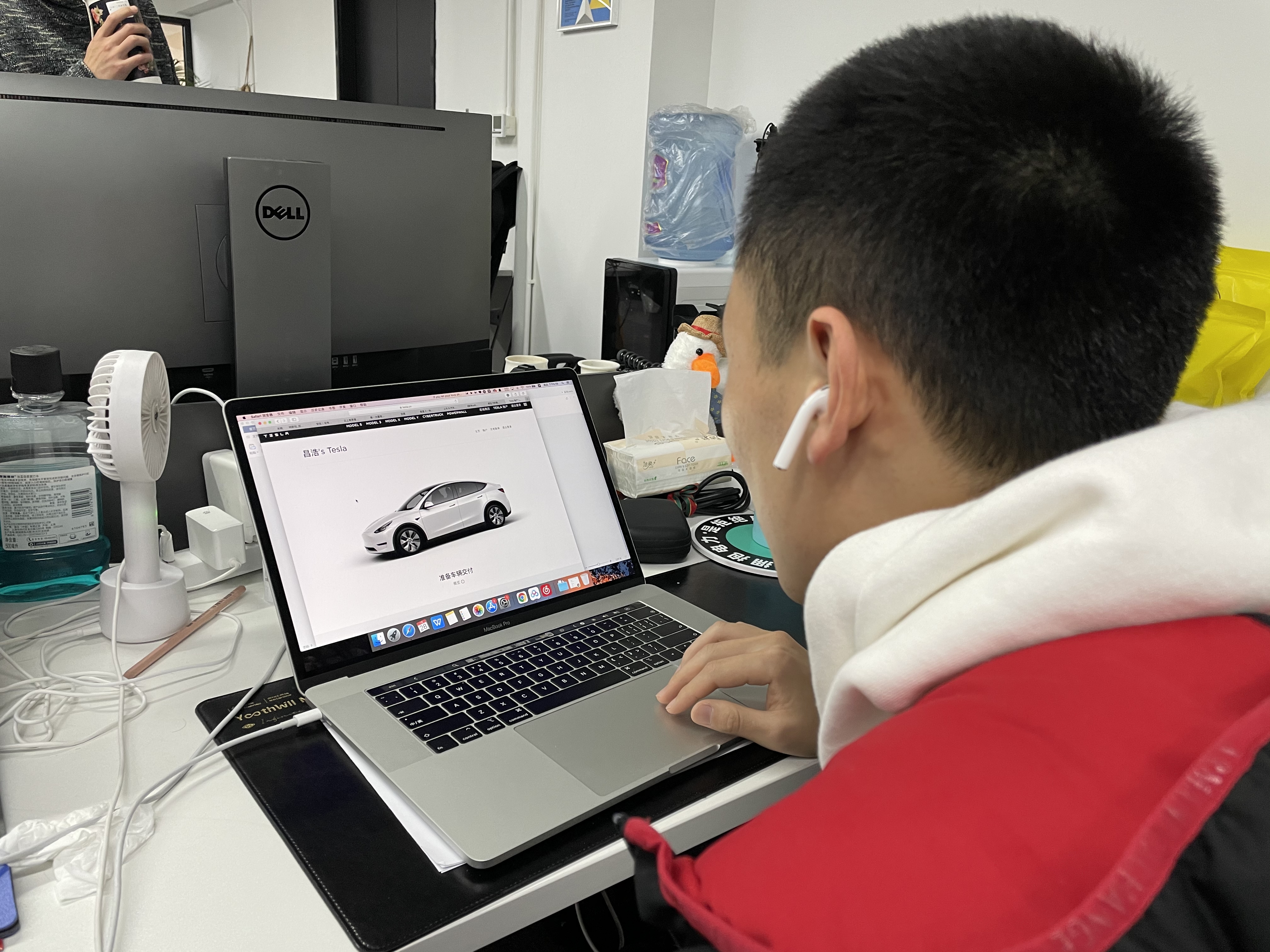
Price cuts, redesigns, new vehicles, self-driving capabilities… Musk and his Tesla seem to always be able to come up with new tricks during this era of electrification in the automotive industry, which they lead.
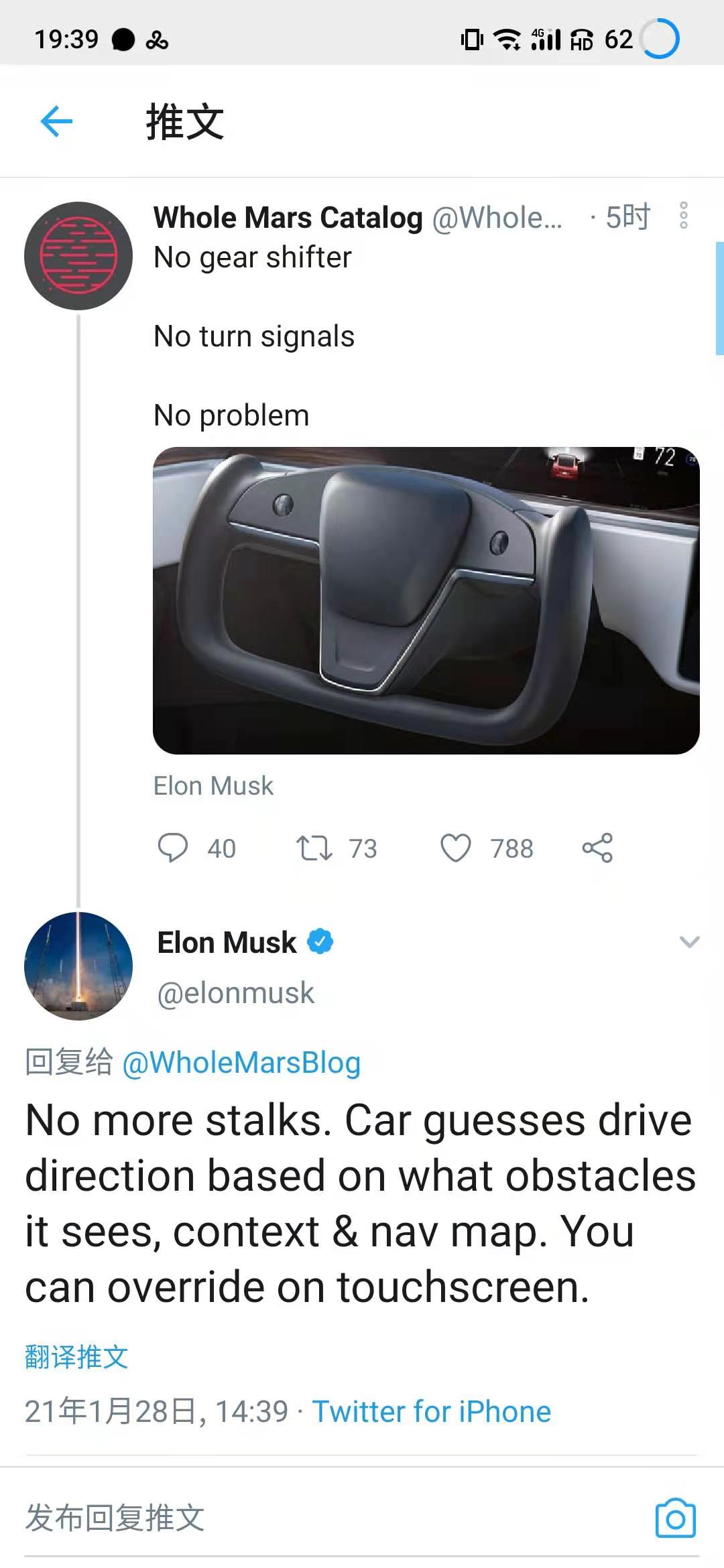
Just now, Musk replied to a Twitter user and said that the Model S/X’s gearshift was automatically inferred by the vehicle based on surrounding obstacles, road conditions, and navigation information, but the driver can also manually change the system commands on the central console.
In this situation, I can only say that perhaps in 2021 we will witness a different “acceleration of the world’s transition towards sustainable energy”.
This article is a translation by ChatGPT of a Chinese report from 42HOW. If you have any questions about it, please email bd@42how.com.
